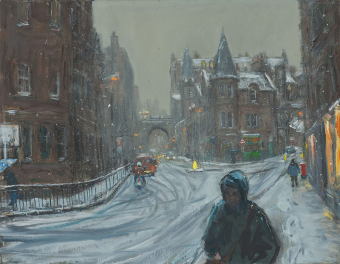
This is a small painting done as a Christmas present, set in a fancy frame picked up in a charity shop for £1. The painting is oil, on arches paper and depicts a Jane Foster mug, something I picked up in John Lewis. The mug's small but a perfect size for an expresso, or a child.
This is a short (6 minute) video from the Royal Academy with artist Anne Desmet showing us how she makes an engraving in wood. Using a sketch she made of a town in Italy as a starting point, it is fascinating to see the work involved and the final result is lovely.
Her web site is here, with a gallery of work, some of it award winning.
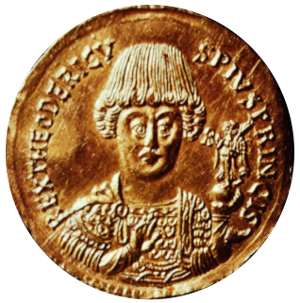
Not a book review (yet), but I have been reading Peter Heather's history of the early medieval period, post-Western Roman Empire, The Restoration of Rome, and finding it very good. Heather's got a way with words sometimes, putting events of the day into familiar terms, sometimes quite amusingly. It might jar sometimes, but he gets away with it because his book is good history with his own research behind some of it.
Right: A medal minted by Theoderic, King of the Ostrogoths and ruler of Italy, early 6th Century.
The period after the political demise of the Western Roman Empire was full of drama, including a lot of fighting and killing (not much change then, perhaps). This included intra-family decimations. Take Clovis, King of the Franks circa 480 AD. To achieve and cement his power, he killed a vast number of people, including perhaps seven rivals, some of them relatives.
From Heather's book, describing Bishop Gregory Of Tours history of the times :
Gregory closes the chapters with a speech Clovis is supposed to have made at a Frankish assembly
How sad a thing it is that I live among strangers like some solitary pilgrim, and that I have none of my own relations left to help me when disaster threatens!
Gregory's comment on this is typical of his own dark sense of humour
He said this not because he grieved for their deaths, but because in his cunning way he hoped to find some relative still in the land of the living he could kill.
So far, a fascinating book. Now we move from the Ostrogoth Theoderic to the Eastern Roman Emperor Justinian.

The Victoria and Albert Museum is always worth a visit, and at Christmas they usually have some good decorations up as well. It's a very large stone building, with lots of space, so it can be a bit chilly in winter however.
On the left is a detail of a wooden carving of Jesus, Mary and Adoring Kings of about 1510 from an Austrian church. Unfortunately, as well as missing a hand, the infant Jesus has a decidedly demonic appearance now. The wooden work has not aged well (one assumes the child was more angelic originally, one would hope).
The nearby Jesus, Mary and Family (below), also Austrian from about the year 1510, has a much more presentable Jesus :
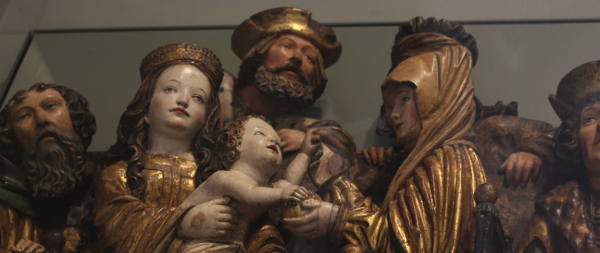
If you like the Christmas story, a visit an art gallery or museum is a good way to see it pictured. The National Gallery in London has an exhibition of two massive nativity paintings by an almost unknown (outside Spain) Spanish artist called Fray Juan Bautista Maíno. His paintings here are very beautiful and extremely impressive, not least the size. The paintings are on loan from the Prado in Madrid until the end of January: the link is to the museum's page on the Adoration of the Shepherds and lets you zoom in. In life, the paintings are over 3 metres high!
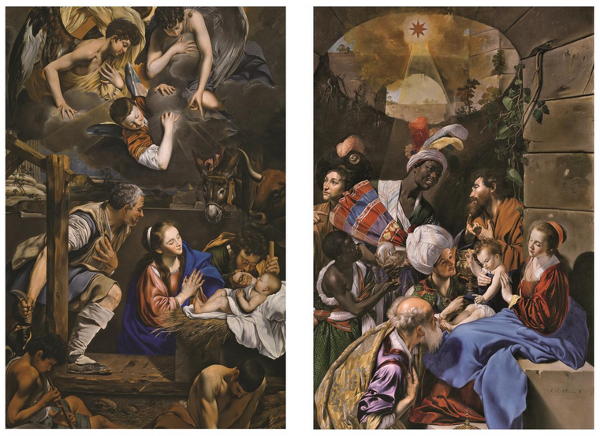
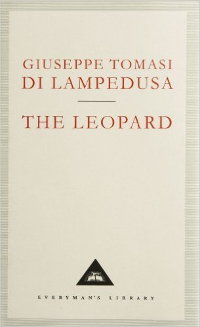
The Leopard
By Giuseppe Tomasi di Lampedusa
Score: 5/5
This edition of The Leopard is a beautifully produced hardback Everyman's Library edition. It is also one of the best novels I have read, and something I thoroughly enjoyed reading.
The book is set in Sicily during the 1860's, Garibaldi has landed on Sicily and the reunification (Risorgimento) of Italy has been set in motion. Centred on the aristocratic family of Don Fabrizio, Prince of Salina, as he struggles to come to terms with the new order and the changes that arrive in a traditional and rural Sicily, the book is funny, sweet, sad and extremely well written (and therefore translated). This is a novel I realised I wanted to savour from the start and was sad to finish.
The introduction by David Gilmour is also well worth reading, as he gives a background to the author. The Prince of Salina, family and household is based on author Tomasi di Lampedusa's similar trajectory :
.. from wealth to penury, from influence to impotence, from an abundance of male descendants to sheer physical extinction. The last Prince of Lampedusa died, childless and impoverished, in Rome in 1957. He left few possessions except the manuscript of a novel which had recently been rejected by two leading Italian publishers".
Similar rejections of what turn out to be classic works is familiar. One wonders how many wonderful works might never find an audience, but must be very grateful that this one did. A wonderful book: I cannot recommend it highly enough.

Olwyn Bowey is an artist I hadn't heard of or seen until I saw a few of her paintings in the last couple of summer shows at the Royal Academy. I liked them so keep my eyes open. She has a small exhibition on at the RA just now: not in a gallery but in the Keepers House. Actually in the Belle Shenkman Room, part of the café.
Below: Tortoise with Alliums, 2016, Oil on board. 69 x 66cm

Below: Cape Primroses, 2015, Oil on board. 72.5 x 77cm

Normally, you need to be an RA "friend" (member) to use the restaurant or café (some of it is swanky), but entrance to see the pictures is free. So it was good to see the inside of the RA member facilities. It was also very quiet first thing, so a perfect time to visit. See it here.
On Saturday I went to the Royal Institute of Oil Painters 2016 exhibition. Amazing show, lots of different artists and lots of great works.
Getting there on a cold morning, and there must have been about thirty artists arriving to take part in the annual show competition: do a plein-air oil painting within half a mile of the gallery and win a prize. Although cold, it was a good day for it, with the sun out and a crisp, winter light.
It is impossible to pick a favourite, or even a reasonable number! One I liked was the large and imposing : On Time by Richard Combes ROI, Oil, 125 x 150 cm. Stunning realism and beautifully executed.

And for something quite different : Cats and Friends by Susan Bower RBA ROI, Oil, 47 x 53cm. She does these quirky paintings, usually people, often with animals, funny. They seem to sell well. I'm not a big fan but I quite like them and they usually bring a smile to your face.

For a good selection of the work, see the Mall Galleries site.
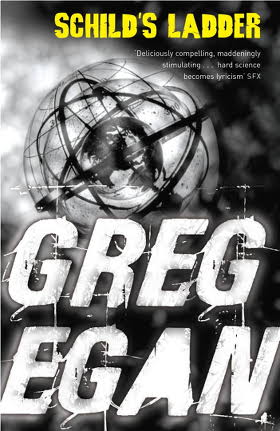
Schild's Ladder
By Greg Egan
Score : 3 / 5
Egan's science-fiction is perhaps the wildest and most speculative stuff I've read, but the wildness comes at a cost: sometimes a lot of exposition of the maths and physics behind it all. Schild's Ladder is a case in point: I have to admit to skimming some of this after a while but still enjoyed the book. This novel perhaps pushed the "hard" science a bit more than usual, even for Egan.
In the far future, a researcher creates a state of vacuum more stable than our own by accident and it starts expanding inside our universe, destroying "normal" matter as it does (at half the speed of light). The novel has two opposing camps of humanity: those that want to reverse and destroy this novo-vacuum, and those that want to stop its expansion and study it.
Right now, both factions are on an outpost (seemingly) pacing the expansion, sitting in front of it and studying it. Fighting, a war of words at the moment. These are not your average humans though: essentially immortal because they exist as information that can inhabit flesh-and-blood artificial human bodies, inhabit artificial exo-skeletons or decide to stay incorporeal. Gender is fluid, AI ubiquitous and everyone seems to know a lot of math! The physics of the new matter inside the expanding new vacuum is described, as well as a mind-bending voyage inside to investigate its secrets. "Normal" space is fairly mind-bending as it is anyway but Egan can stretch things further when we get down to planck scale physics :
The Planck scale is the universal limit, beyond which the currently known laws of physics break. In order to comprehend anything beyond it, we need new, unbreakable physics.
I didn't really care about the characters, and didn't really understand a lot of it, but it is quite a dive into the far future and it is very thought provoking. I hope humanity makes it to the far future.
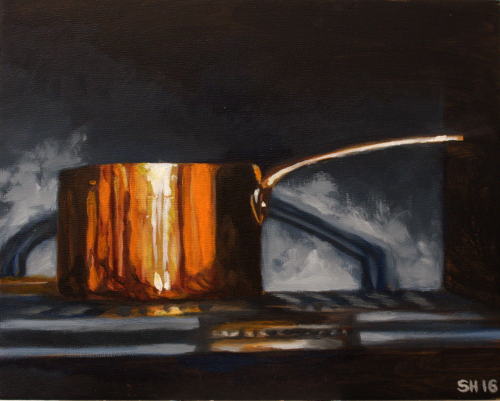
Above: Copper Pot, Oil on wood panel, 10x8" [larger]
This is a painting done via a Will Kemp tutorial How to Paint a Copper Pot in Acrylics. I painted it in oils instead of acrylics. Kemp's done a very nice reference photograph that's lovely to paint because it's got such beautiful and strong contrasts, both colour and light.
I got some of the pot wrong for some reason (e.g. handle shape) but that's not a problem. I made the background too blue originally as well, and thought I over-worked it to fix, but that's not a problem either and I think it looks OK. The "pot" itself is the star here and it's turned out quite well. I hesitate to add extra highlights to the surrounding metal/cooker in case it detracts, and it is all too easy to mess things up. When is a painting finished?
The painting is on a wooden panel (Ampersand artists panel) using Winsor&Newton Griffin alkyd oils (faster drying oil paints). I used white spirit as a dilutant but also some liquin later. I don't like complexity in the process, especially worrying about medium concentrations (fat,thin etc.). I think some parts of the painting have too little oil and show as matte areas: probably too much solvent (white spirit). I may investigate fixing this, or perhaps varnish will in a few months.
The photograph of the work above was taken in my kitchen under a light bulb, then white-balanced slightly, so the quality is not the highest. By eye on my monitor it seems to be fairly true however.
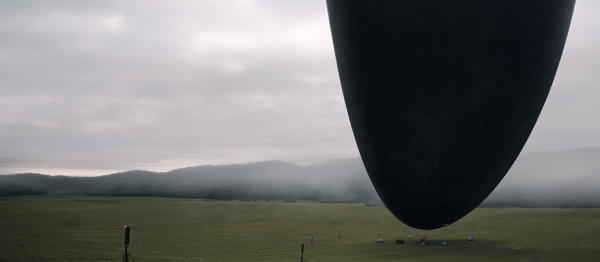
Arrival is a new film by director Denis Villeneuve, based on a short story by Ted Chiang called The Story of your Life. I read this last year.
This is a "first contact" with aliens film, where the aliens are very alien, but not obviously threatening, and we are struggling to communicate with them. The "threat" is human competition, fear and misunderstanding. Amy Adams plays a civilian linguist employed by the army to help try and talk to them, alongside physicist Jeremy Renner.
The film was very good, and a refreshing change from a lot of "speculative" (I hesitate to use the description "science-fiction") films made today. Chiang's story is about language and how much language might define us and the way we see (and are capable of seeing) the world. The story and the film are thought provoking, with the film deepening the very moving back-story (or is it?) of Adams' daughter. I have to admit that I haven't really figured it all out but that's part of the fun of an intelligent piece work sometimes. I would definitely watch it again.

Above: Detail from Michelangelo Merisi da Caravaggio, The Taking of Christ, 1602
When I first discovered renaissance and post-renaissance Italian art, Caravaggio immediately stood out; he became one of my favourite artists. The sharpness of detail in his paintings, striking use of shadow and light and the realism, almost photographic, all contributed to my admiration. Compared to his contemporaries, the people he painted were much less idealised, much more like the people you would meet in daily life on the street. Many actually were.
The current National Gallery show Beyond Caravaggio is therefore a must see, and I went for the second time this Saturday morning. A very wet day indeed, and I got thoroughly soaked on the bike, but worth it.
Only a few by the famous man himself, the show rather concentrated on the artists he influenced. A couple of my favourite paintings are below. The exhibition is a collaboration between the national galleries of London, Scotland and Ireland.

Right: Christ before the High Priest, Gerrit van Honthorst, about 1617
I find this a very powerful and emotional picture, with Jesus standing before the high priest being interrogated. Christ looks completely worn out, tired and all too human as he faces the questioning. He will soon be taken out, beaten and crucified, and he knows it. The single candle is the only light source, and it casts the Caravaggio-like darks and lights. The candle and the pointing finger. A beautiful and affecting work.
Details at the National Gallery site.

Right: A Man Singing by Candlelight, Adam de Coster, about 1625-1635
Candle light figures prominently in the exhibition, as artists use the light cast to generate the deep shadow and bright light that is often so indicative of the style of Caravaggio.
De Coster is an unfamiliar artist but this painting is masterfully done. The only picture I could find of it is not the best reproduction (too dark) but gives an idea. In life, he uses the strong contrast beautifully, including the detail in the clothes of the singer. A very good painting.

Above: The Library Building, oil, 20x20cm
This is a painting from a photograph I took a couple of years ago of the Library Building on Clapham High Street, a (then) recently built residential block on top of a redeveloped library on the ground floor (and an NHS Surgery). A slightly different design to the usual: sometimes it works, sometimes it doesn't. I'm undecided about it. Having said that, I loved the bright blue sky and the single wisp of smoke ascending; a clear, sharp and modern picture I thought.

The Explorer
By James Smythe
Score : 3.5 / 5
I've recently finished reading James Smythe's first book in his "quartet", having read the second a few weeks ago. The wrong order but I don't think it really mattered in this case.
This first novel of the four has a similarly unsettling and claustrophobic narrative as the second; even more so in some ways. It also has a similarly nightmarish trajectory. The Explorer tells the story of the mission of the first spaceship sent out from Earth to meet the "anomaly"; once again things go very wrong. The journalist they take with them ends up faced with quite a shocking story, with himself as the main character.
There are plenty critics of some aspects of this book, particularly the science (it is not realistic). Personally, the science is good enough: it is not a "hard" science book but just the bare minimum to get by and move the story on. This book is really atmosphere and horror rather than science and as such it worked for me and kept me turning pages until the end. One thing, I had quite a feeling of claustrophobia and helplessness here and it might be a good idea to take a break between reading books in this series! That's it for now though. It will be interesting to see how it goes from here.
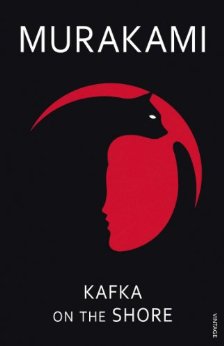
Kafka on the Shore
By Haruki Murakami
Score : 3.0 / 5
I decided to pick up one of Haruki Murakami's books and expected something a little different. That turned out to be true in this modern day story containing so many fantastic elements. Not just a taste of Japanese culture (some) but an odd tale mixing a road trip, a philosophical discussion about life, music and metaphors and an alternate world of magic and myth. As well as people that can talk with cats.
There are two alternating stories which intersect at the end. One follows a fifteen year old runaway, with an odd curse and prophecy from his father; and the other has an old man, simple-minded after losing everything he knows in a childhood accident. The old man is Mr Nakata, unable to read or write but with the special ability of being able to communicate with cats. After a particularly bad day involving a bad man who looks like Johnnie Walker (of whisky fame), he ends up on a quest to fix an old problem. Actually, describing this "quest" and the reasons for it is not easy; one of the problems with the book is that I'm not really sure what a fair amount actually means. There's depth to it, and mythic or fantastical happenings, but much was beyond me. I enjoyed some of the "intellectual" interludes - discussing the meaning of metaphor in life, Truffaut's cinema or the Archduke Trio (YouTube) piece by Beethoven - but they were quite unreal in some ways. It was so full of other meanings that it's the sort of book that needs a followup explanatory text book perhaps. In fact, as wikipedia says :
Metaphysics is also a central theme of the novel as many of the character's dialogues and soliloquy are motivated by their inquiry about the nature of the world around them and their relation to it.
So, there you go. It sounds heavy, but isn't too bad.
Having said this, my mystification was balanced by the charm and oddness of the old man, Mr Nakata, and his companion Hoshino, a truck driver who drops everything to help get him across Japan and complete his mission. Nakata and Hoshino are funny and sympathetic characters ("Nakata isn't very bright"). Hoshino's not the brightest bulb either, but his slow realisation that his life has been pretty meaningless until now, and the way he starts to see the world differently, is one of the highlights of the novel.
The reason for a score of 3.0/5.0 is only that I found some of the boy's story a bit stilted, and there were odd sex scenes that seemed out of place
A book I quite enjoyed then and I'll definitely try another sometime.
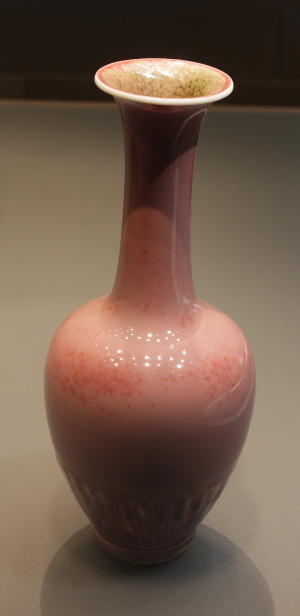
Having watched and enjoyed the recent BBC program about Chinese Ceramics, China in Six Easy Pieces, I thought I would like to see the Percival David collection at the British Museum myself.
The gallery houses a very impressive set of ceramic pots, plates, cups and much else. They range in age widely, some going all the way back to 300 AD. They all seem very well preserved, which is amazing considering the age. I assume they had few, but careful owners.
What is most beautiful to me is often the simplest forms that have the most perfect symmetry and the clearest and most delicate finish. The vase on the right is one example but there are many others. As household objects, most would not look out of place today in the discerning kitchen or living room. Really timeless.
Right : Vase with "peach bloom" glaze, Jingdezhen,Jiangxi Province. 1681-88.
The innovative "peach bloom" glaze was difficult to achieve. Potters covered the vase with a clear
glaze, followed by a layer of copper-rich pigment, possibly blown on, and added further layers of
clear glaze on top. When fired in a reducing atmosphere, this sandwiched colour developed into a
soft mottled red and pink with flecks of moss-green.
As the label goes on to say, Chinese connoisseurs called it "cowpea-red". I think it's good to stick with "peach bloom".
British Museum catalogue page.
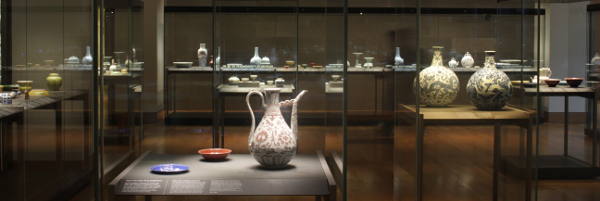
I've painted a new version of the Will Kemp tutorial pot but using oil paints this time. My original was acrylic (per Kemp's original).
Below: Pot Number Two, 20x20cm, oil

This version is not quite as rough and ready as the original painting, and a bit more worked. I wanted something simple to test some new Alkyd Oil paints, faster drying types of oil paint. These are the sorts of paint the artist Peter Barker used at the Mall Galleries recently, diluting with white spirit only.
I didn't think that highly of the original painting, but over the last couple of years it has grown on me. Simple but "rustic", and very basic; but sometimes a piece if art is all the better for that.

I recently visited the Science Museum, the first time in over 25 years!
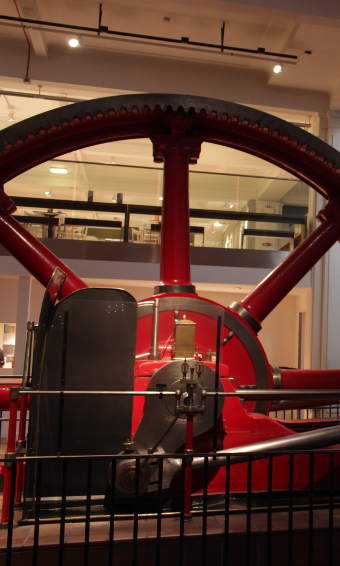
It's on multiple levels, an IMAX screen and lots of big machines to look at. As well as the old steam engines (excellent engineering displays), it's quite up to date with sections on "big data" and the implications of the "sharing" culture. A lot of light and colour, plus neon, in some large cavernous spaces. A lot of space is needed to hang aeroplanes and rockets.
One thing I wondered as I looked around was how they ever managed before the introduction of the touchscreen: they are everywhere. It's pretty impressive being able to interact with the displays and there's a lot to take in, with a big emphasis on learning. In fact, the place really needs a whole day, at least.
Something that caught my eye was a very large (about two big freezers) metal box callled an Ampex VR1000A, a 1958 video recorder. A lot of people thought recording television was impossible: until someone actually managed to do it! According to the label, this required one and a half miles of tape to record 4 minutes of television.
Below: An Ampex VR1000A video recorder :

It's been a while since I've done any painting but I've done one in acrylic for a change, wanting something that dried quickly. Also a change over oil. I'm fairly happy with it, although the usual caveats: I find it hard to take a photograph that represents the actual colours satisfactorily. A little too saturated I think.
Below: Purple and Green, Oct 2016, acrylic, 7"x5".

I bought some Winsor & Newton Griffin oil paints. These are alkyd based oil paints, so faster drying; perhaps a good compromise between standard oils and acrylics? I've already tested them, painting another version of the old pot, and am quite impressed. This new painting is a little less rough and ready: I'll post a picture I hope.

The Echo
By James Smythe
Score : 3.5 / 5
A team of people is sent into space to investigate an "anomaly": a region of complete darkness, perhaps growing, and perhaps heading our way slowly. Twenty years previously, another spaceship sent on a similar mission failed to return and its status is unknown. Things do not go as planned and a quite shocking sequence of events await them in space, something even the best brains on the planet could not imagine.
I really enjoyed this novel, even though it was hard initially to get over the narration by one of the twin scientist brothers sent into space. He "won" the lottery; his brother stays on earth as mission control. Both are quite unlikeable: very clever but very "nerdy", probably autistic. However, the story takes off and it definitely keeps your attention.
The front cover blurb comparing this book to the film Gravity ("If you liked Gravity ...") is ridiculous but another blurb gets it just about right : Creepy and compulsive. This is definitely creppy and even horrific, an unsettling sequence of events that takes us into the Twilight Zone.
I do have one complaint here. Apparently, this book is book two in a quartet, but this fact was well hidden. It seems that the first book covers the original, lost mission. I don't think this matters in the end, The Echo seems to work standalone. But a bit annoying nonetheless.
Following on from the DDOS Brian Krebs was hit with a week or so ago, he writes about certain Chinese "Internet of Things" companies :
I don’t normally think class-action lawsuits move the needle much, but in this case they seem justified because these companies are effectively dumping toxic waste onto the Internet. And make no mistake, these IoT things have quite a long half-life: A majority of them probably will remain in operation (i.e., connected to the Internet and insecure) for many years to come — unless and until their owners take them offline or manufacturers issue product recalls.

One of the many appalling things about these things is that many just cannot be secured at all. It's all smoke and mirrors : the web interface might let you change the default password, but this might not actually save it. Or there are other default passwords (for other routes into the system) that cannot be changed.
Some security experts are now coming round to the idea that the government might need to step in and mandates some fixes. The EU appears to be starting down this route now.
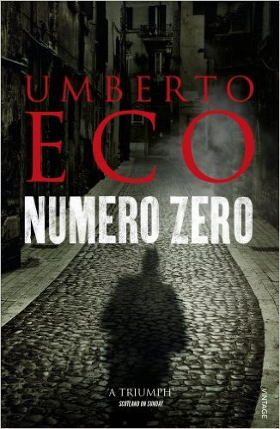
Numero Zero
By Umberto Eco
Score : 2 / 5
Eco's last novel before he died this year is not one of his best. It has his love of meandering conspiracies and secret history, but is a short and slight book without much depth. It meanders itself to a disappointing conclusion.
Set in the 1980's, some of the book is very funny and a lot of it reads like satire on a certain type of news business. Italy has a Street of Shame just as grubby as ours. It also has a full complement of very shady characters and plots, something Eco spends many pages describing. Unfortunately, the funny bits and the local colour cannot save it.
Losers, like autodidacts, always know much more than winners. If you want to win, you need to know just one thing, not to waste your time on anything else: the pleasures of erudition are reserved for losers. The more a person knows, the more things have gone wrong.
I notice a blurb on the cover of the paperback : "A Triumph", Scotland on Sunday. Just like movie advertising and blurbs, completely untrustworthy statements! You cannot trust anything a publisher chooses to stick on a book as an enticement.
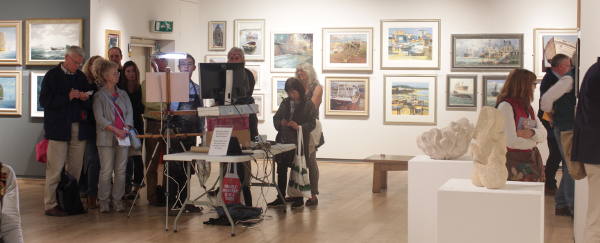

I was at the Mall Galleries on Saturday for the Royal Society of Marine Artists 2016 exhibition, so lots of boats, water, sea, beach and coast. All things that make amazing art works basically, and as usual, the show did not disappoint.
I noticed that the artist Peter Barker, who I'd noted during the day as a favourite, was doing a live oil painting demo on the Sunday, so went up to the gallery again to see this. I only stayed a couple of hours but it was well worth the trip again. A very personable, patient and helpful guy; a great opportunity to watch an artist at work in the flesh.
Below are some examples of his work. He's very good with light, light on water, sunny "glows" and, as I mentioned to him at the gallery, "mud".
Have a look at his web site.



The Mall Galleries web site has a good section on the show, and the Royal Society of Marine Artists site is also worth a look. So many great pictures.
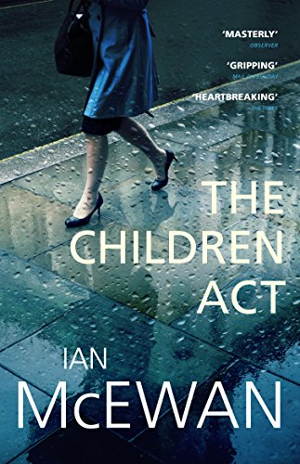
The Children Act
By Ian McEwan
Ian McEwan seems to be a prolific author and one of the major writers in English. He's been nominated for a few Booker Prizes as well, and won it in 1998 with Amsterdam. With that, there's a certain assumption of a good read. This is the first of his books I've read: a short one but good.
The Children Act is about a high court judge, Fiona Mayes, who works in the family courts: so there is much divorce and child cruelty in her life. In this book, she's having a few marital problems herself when a case comes before her: a seventeen year old boy refusing a blood transfusion because of his religious faith. The book looks at the moral choices here and the limits of law, coercion and our individual rights. To me, the professional interactions in court were the best part of the novel, and the to and fro between Mayes and the boy in hospital were also riveting. Some surprising and beautiful musical references as well.
A good book, and I expect to read more from him in the future.

In The Guardian, David Hockney spoke about some of his favourite painters a few weeks ago, an extract from a book he has written with Martin Gayford.
[link]
Hockney talks about Giotto, Masaccio, Van Eyck and Vermeer and, at the end, brings up Rembrandt :
In a way, Vermeer and Rembrandt are opposites. But Rembrandt is the greater artist, I think, because he’s got more ingredients than Vermeer. Rembrandt put more in the face than anyone else ever has, before or since, because he saw more. And that was not a matter of using a camera. That was to do with his heart. The Chinese say you need three things for paintings: the hand, the eye and the heart. I think that remark is very, very good. Two won’t do. A good eye and heart is not enough, neither is a good hand and eye. It applies to every drawing and painting Rembrandt ever made. His work is a great example of the hand, the eye – and the heart. There is incredible empathy in it.
Rembrandt's artistic output was many times greater than Vermeer of course, who is thought to have painted only about 34 pictures (source).

A computer and network security journalist I often read was in the news last week when his web site was knocked offline by criminals using a "botnet". This was Brian Krebs' web site Krebs on Security (now up and running again).
A botnet ("robot network") is a large collection of compromised computing devices used to overload target computer systems and thus make them inaccessible to everyone i.e. they are unreachable. So many network requests are continually made that the web site cannot cope. These compromised systems could be computers, network routers or, increasingly, so called "internet of things" devices such as security cameras, home monitoring systems, printers, baby monitors and numerous other connected boxes. More and more things are connected which will lead to more and bigger security trouble: even all the way to National Security trouble if people can attack things like the power grid, transport or utilities.
A lot of computers and networking equipment, especially consumer devices, are shipped in a barely secure configuration; many are wide-open to attack. Even for people who know what they are doing, systems can be hard to secure or, in some cases, impossible. Computers are not easy to use and can be baffling and inconsistent. Yes, even Microsoft Windows 10 and Apple Mac OSX; to say nothing of whatever your internet router is running. Most people neither know or care what the "wifi box" runs, and never update it. Often the manufacturer never creates updates anyway, so security bugs sit unfixed. All these things are ripe to be made welcome into someone's botnet No one knows how to fix this mess.

As I read some commentary about the attack on Brian Krebs' web site (a "DDOS", Distributed Denial of Service), I saw a link to another article by Naoki Hiroshima on how he was scammed out of his twitter username. Having a twitter username "@N" made him a constant target for scammers trying to steal it, and eventually they did. They did this by taking over (stealing) his email address. The details are in his post :
How I Lost My $50,000 Twitter Username
One thing that stood out for me after reading his account was his recommendation regarding the use of your own domain for logins e.g. you@yourname.com. This is fine, as long as your domain is secure, because if it isn't and gets stolen, password resets for any of your web site logins are now in the hands of the thief. Using Google GMail or Yahoo Mail email addresses might be better because they are likely to be more secure. Hiroshima's email domain was stolen because the thief swindled his domain management over the telephone; Google or Yahoo would (hopefully) be harder here. They also allow the use of "two factor authentication", using a smartphone based code as well as a password.
So, for standard email messaging, no problem. But account logins? Perhaps worth reconsideration.
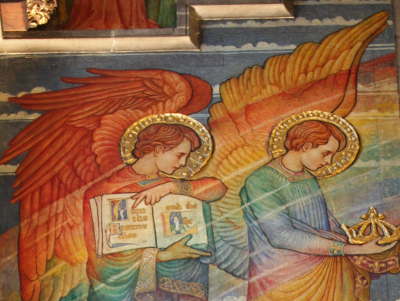
I was recently in Edinburgh again, and visited the Traquair center again.
This is to see the great Phoebe Anna Traquair murals of course. I've been here before but I could come back again and again to see them. Beautiful and inspiring. They're only open a few days a year (more during the festival), so it is worth timing your visit. The open day schedule is on their web site.
More on my visit to the city later, I always manage to cram in a lot of culture, and coffee!
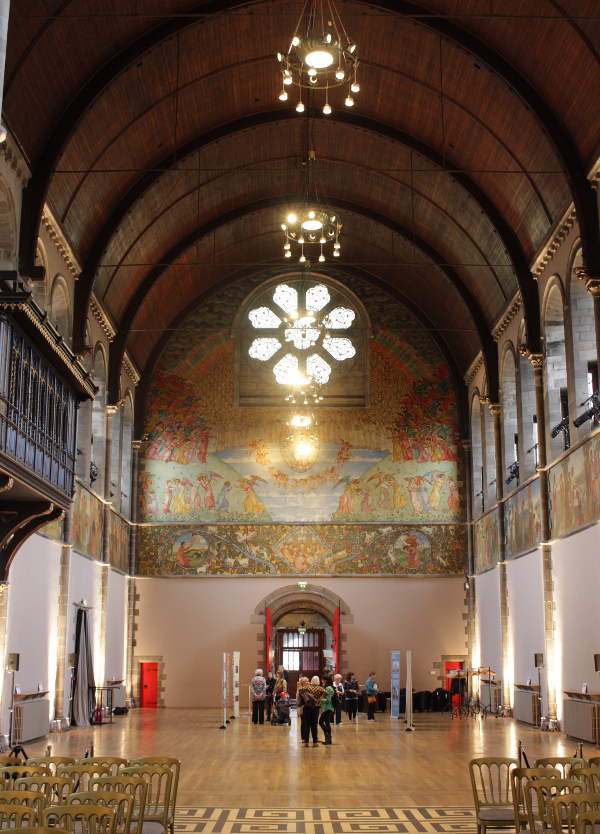
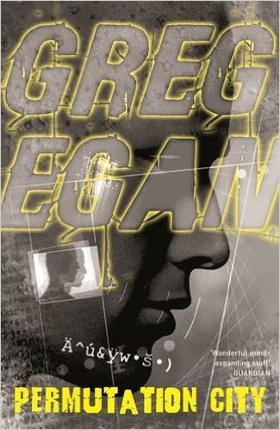
Permutation City
By Greg Egan
Greg Egan writes a form of science-fiction often labelled as "hard", meaning that he's careful to use believable science close to what we think is real or possible, at least potentially. It might also mean that his work is sometimes quite difficult to understand. Having to think a little is a good thing sometimes though.
Permutation City concerns a mid-21st Century future where we can scan ourselves and create a digital "Copy" running on a computer. This is not a new concept of course, but it is explored in new, and sometimes slightly unsettling ways by Egan. Your flesh and blood self might die, and your "Copy" is all that's left of you. Is it "you"? What if your "Copy" decides to clone or copy itself, running another copy, perhaps in a simulated computing system inside a computer.
In this world, after being scanned, you wake up with a marker pen message scrawled on your arm : "you are not the copy". If you wake and look for this message, expecting to find it but don't?
I really enjoyed this novel, even though I had to stop trying to understand the "theory" behind a lot of it (Egan has a FAQ (Frequently Asked Questions) page for some of this stuff). To me, it is a "mind-blowing" type of book: something that makes me think about odd scientific and existential concepts. Philosophy as well. I think this is a worthwhile thing to do.
In 2975, the orphan Yatima is grown from a randomly mutated digital mind seed in the conceptory of Konishi polis.
Not your average novel, but science-fiction does throw up some amazing work sometimes. It's a shame that the "genre" (is this the ghetto?) gets side-lined or looked down on so often. These are very memorable books exploring some deep philosophical concepts.
Ove Arup, engineer, architect and designer, called the way he worked "Total Design". He meant to express the importance of the engineer, as well as the architect and designer in the the task of construction, whether opera houses, penguin pools or bridges. Total Design is the sub-title of Engineering the World at the V&A.

The exhibition takes place in what appears to be a big meccano set, which is perhaps fitting. The framework is actually made up of (so called) gerberettes: a suspended beam and a short propped cantilever. This design was used for the Centre Pompidou in Paris, an Arup engineering building.
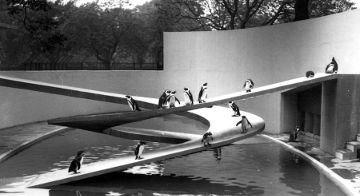
Early work included the Penguin Pool at London Zoo (see left). Designed by Berthold Lubetkin and Arup in 1935. Complicated to build, and the V&A shows off some handwritten maths working it all out to prove it.
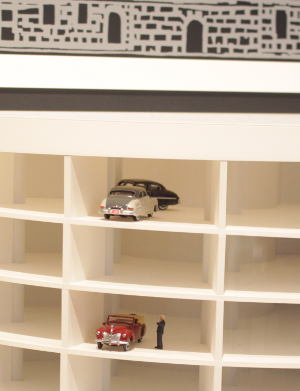
During the war, Arup worked on air-raid shelter design and also a component of a floating harbour used at D-Day. Some of his air-raid shelter designs were to protect a lot of people underground. Post war, he suggested they could be used for car parking.
On the left, the street level is at the top of the image.
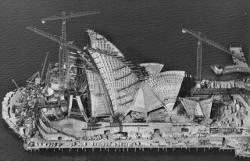
This is not the sort of show I'd normally visit but it was very interesting. Ove Arup was a Dane (although born in Newcastle) who moved to the UK in his 20's and spent the rest of his life here. He studied philosophy first in Copenhagen before starting on engineering and as the show states, he formulated his own philosophy, something he called "Total Design": the architect and the engineer should be the closest collaborators from the start.
It is strange to think that the usual way of working in his early days was for the architect to produce designs with no input or thought to the engineering. Consider Jørn Utzon's design of the Sydney Opera House, little more than rough sketches originally. Many thought the design was impossible to build, and indeed changes were needed. But Utzon, Arup and his team managed to do it (against quite a few odds).

On the right, a Pegasus Mark 1 computer from 1957.
The mathematical calculations used to design the London Zoo Penguin Pool are on show, the long-hand mathematical scrawls hopefully correct, and hopefuly keeping everything in order. Computers started being used in the early sixties and made an immediate impact. Arup was a funny and engaging character and we can listen to a speech he delivered in 1967 as a "christening" of a computer he called "Mumbo Jumbo" (a funny acronym actually). "Mumbo" or "Mum" for short :
When in trouble come to Mum, Mum will do your little sum.
These early computers are large cabinet sized things, greatly superceded now by the smartphone in your pocket. Note the 1960's analog clock on its side.
We can see some of the company's current work on London's Crossrail, as well as a window into its software development, such as crowd simulation or air flow. The Pegasus 1 would have you waiting a long time for results to these sort of equations (to say nothing of the amazing visualisations we now have). We also have a Soundlab room that lets us see and hear work done to simulate and improve the acoustics of buildings: not just theatres but railway station platforms.
Arup the company is still going strong, but the man himself died in 1988.
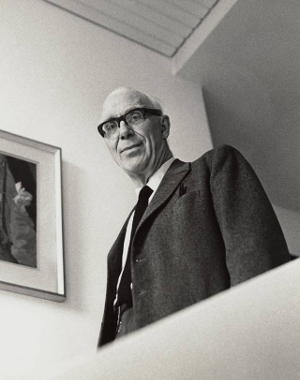
Ove Arup, 1895-1988

A very large, yellow crane on Tottenham Court Road yesterday. I think it was dropping something onto (or into) the building being completed on the right-hand side.
Earlier on, there were a couple of guys walking on the gantry being carried over on the middle-right. I don't think I'd be happy doing a job like that: I don't have much of a head for heights. Beautiful day for it though, and it must have been quite a view. "Crane operations" are quite common in London at the moment.

Sapiens
By Yuval Noah Harari
A popular book, displayed in the bookshop prominently and also heard discussed in its aisles. It has all the usual laudatory blurbs on the cover but I try and train myself to ignore these as much as I can. They're a bit like film trailers: completely unreliable indicators.
Harari's book covers a very long period (millions of years initially, then tens of thousands) as he traces the rise of homo sapiens (the "wise man") over all our brother and sister humans (erectus, neanderthal etc.). We've been very successful but some of that success as come at a great cost to other things, including other animals. Perhaps we're reaching the limits of our ape brain : cue his new book Homo Deus (Guardian article), "A Brief History of Tomorrow".
I enjoyed the book, particularly the way he discusses things like our "cognitive revolution", when our brains grew and we developed tools, technology and better organisation. Also, his description of Sapiens sharing myths that bind and enable such large scale group organisation. These "myths" might include the usual things such as religion, but also the value of money or even the Limited Liability Company. Some of his discussion grates slightly though, such as his use of a phrase like "some religions, such as Christianity and Nazism, have killed millions out of burning hatred". Well, in context, perhaps. But such a needlessly provocative way of expressing this here will alienate people.

Above : Cave of Hands, Argentina. Paintings of human hands from 13,000 to 9,000 years ago.
From wikipedia. CC BY-SA 3.0
The book is best during its first half, as it becomes more a sociological and current affairs discussion in later chapters. Interesting and thought provoking though, just not as deep as some might think.
The BP Portrait Award 2016 is on at the National Portrait Gallery. Always worthwhile, and always very humbling seeing how much good work there is around. I've been twice now.
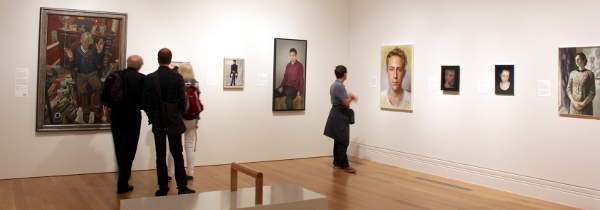
Below are two of my favourite paintings, but there were five or six others.
Left : Francesca by Daniele Vezzani (here)
Right : Pearl in the Morning, Ready for School by Samantha Fellows (here)
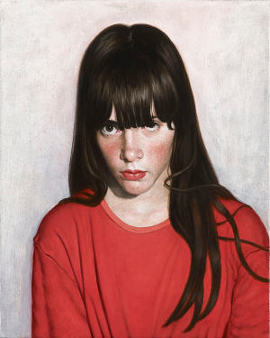
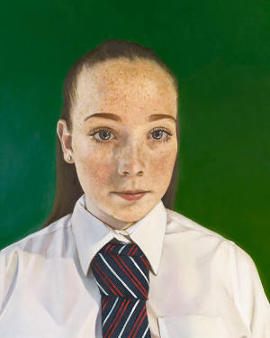
All the paintings are on the NPG website.

The future of work has been in the news off and on for a while, especially as AI and robotics start to make more of an impact. Lorry drivers are one profession said to be threatened by self-driving vehicles, but many white-collar employees are also at serious risk. For instance, computers can do very efficient legal discovery (and a lot more cheaply). We might start seeing higher unemployment, more underemployment, lower wages and the need to work much longer. Tornadoes weaving a path of destruction through the workplace?
A couple of years ago, The Economist magazine talked of :
Just as robots became ever better at various manual tasks over the past century—and were therefore able to replace human labour in a growing array of jobs, beginning with the most routine—computer control systems are able to handle ever more of the work done by human administrative workers. Jobs from truck driver to legal aid to medical diagnostician to customer service technician will soon be threatened by machines. Starting with the most routine tasks.
The article above starts off quoting David Graeber on his labelling many jobs as "bullshit jobs" (Strike Magazine), massive swathes usually administrative jobs in areas like health administration, human resources and public relations. A very different type of economy from the "classic" one of people designing and making things. I might argue that this has really always been the case however, at least since the Industrial Revolution.
David Graeber (author of Debt: The First 5000 Years and LSE Professor) :
While corporations may engage in ruthless downsizing, the layoffs and speed-ups invariably fall on that class of people who are actually making, moving, fixing and maintaining things; through some strange alchemy no one can quite explain, the number of salaried paper-pushers ultimately seems to expand, and more and more employees find themselves, not unlike Soviet workers actually, working 40 or even 50 hour weeks on paper, but effectively working 15 hours just as Keynes predicted, since the rest of their time is spent organising or attending motivational seminars, updating their facebook profiles or downloading TV box-sets.
Maybe the French have a word for this :
I was at the V&A on Sunday looking at some ceramics and glassware. The sixth floor was almost empty, apart from me and three or four other people (later). But there are still guards around, all day, every day. Lots of interesting things to look at and read, but the job seems to be very very dull.
Some glass ornaments and sculptures were extremely striking :
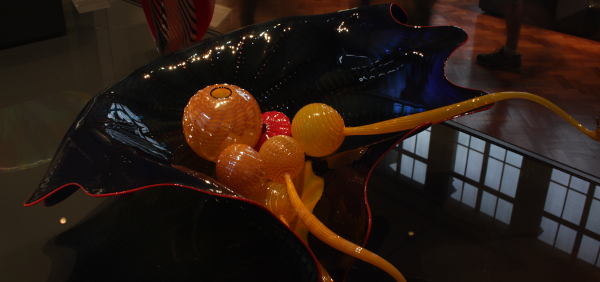
Above: Deep Blue and Bronze Persian Set by Dale Chihuly, 1999.
From the museum label :
Originally reminiscent of the tiny core-formed bottles of ancient Egypt and Persia, the 'Persians'
series was begun on 1985. Since then Chihuly has developed the series into a range of different
shapes , the outer ones often of enormous size.

From the New York Times :
Standing in front of the David was, by far, the most powerful experience I had ever had with a work of art. The statue is gigantic: 17 feet tall, three times the size of an actual man, the height of a mature giraffe — another fact that no one had ever told me. I had always assumed, based on the images, that the David was life-size. To find otherwise seemed like a category error, like arriving at the Taj Mahal to discover that it is actually the size of a walnut. There was an existential snap in my brain, a sudden adjustment of the relative values and proportions of every other object in the world, including me.
I know the feeling. It is an absolutely stunning work and many years ago I had the same reaction on my first view of the statue: amazement that it was so big.
The article describes some serious problems with the giant statue though, weak ankles that may make it susceptible to collapse in some circumstances. What a disaster that would be, even though we have a full size cast replica at the Victoria and Albert Museum (as does Florence itself of course).
Maybe things are not as bad as they can seem, although the museum director does worry about earthquakes. But as the outgoing director says :
We have known about these cracks for more than 100 years, he pointed out, and they aren’t getting any worse. The David is now perfectly upright, and he is one of the most closely monitored artworks in the world.
Let's hope the Italian's sort out the "antiseismic base" soon though. There is a good page on Michelangelo’s David at the Academia.org site.
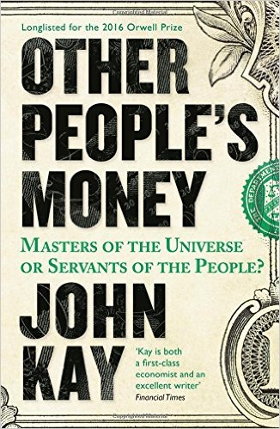
Other People's Money
by John Kay
In Edinburgh, Kay remembers the old days as a schoolboy in the 1960's when a career at "the Bank" or "the Royal Bank" was an aspiration for boys whose grades were not good enough for admission to a good university. As he details in his recent book, things are very different now, with a career in Finance attracting the best and the brightest. The world has changed, much for the worse. These things might be linked.
Kay's an excellent writer and every page has something worthwhile on it, and quotable. He's scathing about the way "financialisation" has taken over the financial industry. A tremendous amount of money is now floating around the system and a equally massive number has inflated the pay packet of large numbers employees in the finance industry. This does not include the average retail bank employee though: closer to shop assistants now. Lots of money to be made "trading" though, but, as Kay asks, what is all the trading for?
There seems to be a huge disconnect now between the needs of the real economy and the financial system today; a system that trades mostly with itself and, seemingly, mostly for its own benefit. And the bottom line is that all this is with other people's money. Prudence is weak or non-existent and abuse easy, widespread and unpunished. After all, fines levied are paid with other people's money.
The title of this post, I'll be gone, you'll be gone is another of the sticks he uses. Like much of politics today, there is a mostly short-term outlook taken and people know that the results of their activities will be felt long after they've left the industry, usually amply rewarded. I'll be gone, you'll be gone.
"We are investment bankers. We don't care what happens in five years."
Vincent Dahinden, head of global structured products, Royal Bank of Scotland in
Institutional Investor, 12 February 2004. Quoted in Ian Fraser, 2014. Shredded. Inside RBS, the Bank that
broke Britain p 222. Royal Bank of Scotland was bailed out by the UK taxpayer four years, eight months later.
Depressingly, Kay is pessimistic and thinks that we missed the opportunity to fix things. It was right to backstop the system and prevent a collapse in 2008 but :
They might have used the control of the finance sector they achieved in the aftermath of the crisis to restructure the industry. But they did not, and that makes it certain that they will get another chance - perhaps to make similar mistakes again.
Great book, well written. I wish there were more people like Kay around, and I hope our politicians, financial regulators and economists listen. As The Economist says :
Above all, the finance sector should be judged on the same basis as other industries; if an activity is unprofitable without taxpayer support, it should not occur. “Our willingness to accept uncritically the proposition that finance has a unique status has done much damage,” the author wisely says. Let us hope those in authority will listen.
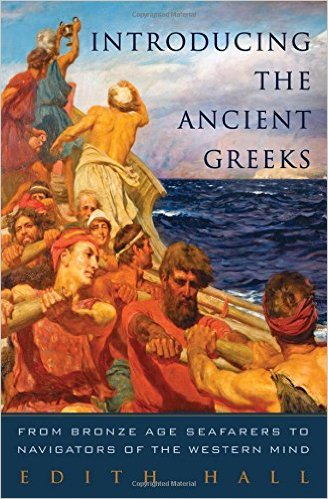
The Ancient Greeks
By Edith Hall
Edith Hall is a professor of classics at Kings College in London and has appeared on television and radio, including many episodes of In Our Time with Melvyn Bragg. So, having seen and heard her, I knew she had expertise and also a skill in communicating it.
In her recent book, she introduces us to the ancient greeks and their world using ten characteristics she identifies. These are such things as curiosity, humour, a distrust of authority and a love of excellence. The book is up to date on new research and discoveries in recent years and includes a number of observations and facts that were new to me. There is no shortage of writing on this particular subject, and I've read quite a few, but this book is a worthy addition and very well written. Not over-long, but still erudite, and highly recommended.
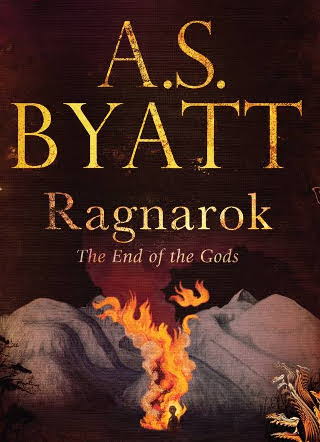
Ragnarok
By A. S. Byatt
This is a thin book, but not slight. The "thin child in war time" is obviously Byatt herself but it is not really autobiographical, or really a novel.
The child finds pleasure and escape reading Asgard and the Gods by Wilhelm Wägner, a book published in 1880 that retold "tales and traditions of our northern ancestors". The Norse Gods. She prefers these darker, less optimistic and stranger tales to those she is told at church.
One of things that suffuses these tales in the inexorable slide towards the final terrible battle, the judgement and demise of the Asgardians. They know this and accept it.
After a long time, the fire too died. All there was was a flat surface of black liquid glinting in the small pale points of light that still came through the starholes. A few gold chessmen floated and bobbed on the dark ripples.
The Norse myths do not appear to have had any time for a resurrection or an afterlife, at least after the final world destroying, and god destroying battle. The girl finds this oddly satisfying. I think Byatt gets the sombre feeling quite right in her telling of these old myths and, like the "thin child", I found that very fitting as well.
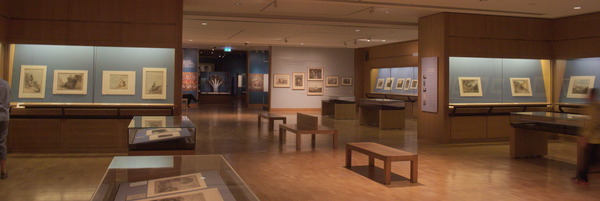
The British Museum's prints and drawings room is one of my favourite parts of the museum. It's quieter, away from the hustle and bustle of some of the more popular areas, and the hordes of the mobile-phone obsessed.
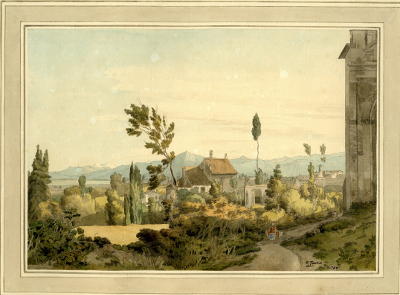
The Light, time, legacy exhibition closes in a couple of weeks. I had a final browse at Francis Towne's wonderful watercolours of Rome and Italy, painted in the late 18th and early 19th centuries.
Right: Temple of Bacchus in the Distance, Francis Towne, 1780. View outside Rome (source)
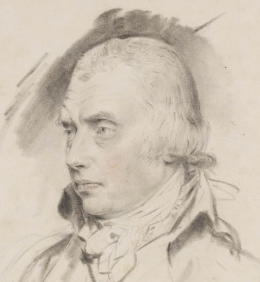
Towne didn't get on so well with the Royal Academy of the day (no election for him). Many there looked down at the artist who also taught art, and Towne and others seemed to think of them as a metropolitan elite (echoes of today). Sometimes, the ancient ruins were seen as warnings not to repeat the mistakes made by the romans that lead to their corruption and fall.
Finally online, the Paul Mellon centre now has an amazing web site devoted to the man and his work. Worth the wait :


Gut
by Giulia Enders
This is not a big book, and it's written in a bright and breezy way that is very easy to get through. I like a good science book but normally stay away from anything too funny or humourous; but I actually found myself smiling, and in some cases even laughing. She definitely has a way with funny asides and descriptions (of things normally swept under the carpet, or into the toilet, as she might point out). Case in point, near the beginning is a section How does pooing work? I think this is worth considering.
Enders has a scientific background, doing a medical doctorate at the Institute for Microbiology in Frankfurt, so has some expertise in the field. She describes a lot of very interesting research done in the past few years that have really highlighted how important our gut health is to us. We are home to trillions of bacteria, most in our large intestine, and this alone is a staggering fact. There might be more to having a "gut feeling" than we think, especially when we factor in the enteric nervous system, a "second" brain that runs through our body and is tied to our gastrointestinal system. Our gut bacteria and their health might govern a lot of things, from diabetes, to obesity, to stress and depression. This also makes diet very important.
Enders is a student who's become a minor celebrity in Germany, where the book became a bestseller on its release two years ago. She's interviewed on YouTube as well (a good, brief overview of her work). Great book to read and quite eye-opening in the implications for our health. Listen to what your gut is saying.

I was at the V & A last weekend, this time looking at Ceramics, inspired by Byatt's Children's Book. The potter's craft is lovingly articulated in her novel.
I've seen and admired this stuff before, but I do like this Italian renaissance Maiolica. Some of it has a real quirky charm, as well as being beautifully painted.
The term 'maiolica' was used in 15th-century Italy for lustrewares imported from Spain. The V&A has one of the greatest collections of Italian maiolica in the world; the Museum holds more than one thousand of these rare and precious objects.

The Childrens Book
By A. S. Byatt
I read Possession a while ago, and loved it, so have been wanting to dip into more Byatt books. This was almost as good and like all good books, I looked for reasons to sit down and carry on reading. It is beautifully written and extremely moving in parts.
The story follows a bohemian family, parents, children, friends and acquaintances, for a few years of the late 19th century and into the early 20th. The Wellgood family is a mix of Fabian Society socialists, artists, writers and dreamers, with the mother, Olive, doing most of the earning writing books full of magic and myth. She also writes a story book for each of the many children she and her husband have, weaving their own tale of magical journeys and shape-shifting animals and humans. The real world is boiling with economic and class conflict but many artists of the time were inventing their own worlds. As one of the boys says of all the poverty around, why can't we do something about it?. There's a lot of art, and a lot of discussion but the organising and action is not always present.
The paths of the characters sometimes cross with those of real historical people, like Rodin, Wilde, Shaw and the Webbs. The milieu is one of social improvement, Morris' Arts and Crafts movement and some Utopianism. We watch and partake in the building of the new Victoria and Albert Museum. There are some wonderful descriptions of the craft and art of pottery, and the method of moulding and firing clay. The V&A is a grand museum with a lot of good pots to have a look at.
How do we get out of dreamland? Hic Labor, hoc opus est he said.
"In this task, the labour lies" from Virgil's Aeneid.
Great book, and I've now queued up another of hers: Ragnarok.
This is not the first time I've read Byatt and wished I'd done so on an ereader, so I could highlight a word or phrase and find out what it means. I was not distracted from the enjoyment of reading though, and where I could, I placed a "tag" on the page and checked for meaning later, as with the Aeneid quote above. Some books deserve a bit of study.
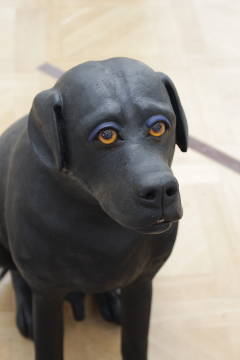
Time for the 2016 Royal Academy Summer Show, one of the big art events every year. Another being the Not the Royal Academy at the Llewellyn Alexander gallery of course.
I went a couple of weeks ago to have a look and, as usual, some excellent things to see, as well as a lot of stuff I didn't like, or didn't see the point of. Always an interesting show though.
The galleries are worth a browse. The works are generally a lot more expensive than I usually see in other places, a function of this being the ACADEMY and these artists are often better known, with a history i.e. most have "made it". Good luck to them.
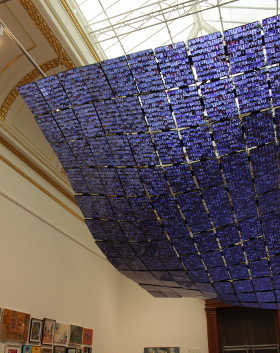
Left: Hanging from the ceiling, hundreds of LCD screens are alive, flickering and changing. This is The Portrait of Sakip Sabanci by Kutluğ Ataman.
Detail: "a multi-image work of some of the thousands of people, from all walks of life, whose paths crossed Sakıp Sabancı's in some way."
link

Big rooms, high ceilings. Pictures hanging higher up are hard to see properly though.
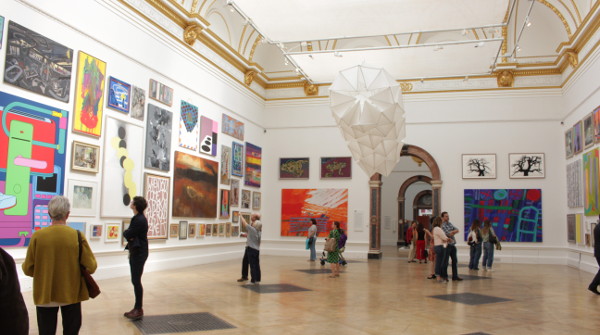
Below: This was a very large painting, well done and very arresting.
RA! by Andrew McIntosh
link
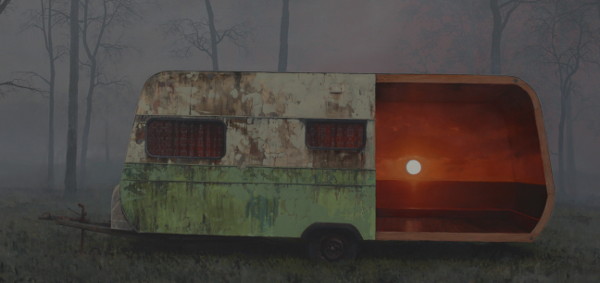
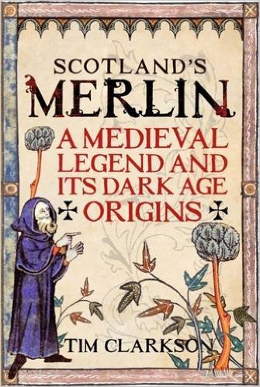
So, back to the "dark ages".
Because Travelling Heroes was quite slow, I decided to have a look at another recent purchase, Scotland's Merlin, and before I knew it, I'd finished it first.
Most people associate "Merlin" with the King Arthur stories, but this is a later addition with no historical basis at all. The evidence for a Merlin, though slight, is actually greater than that for an Arthur.
Simon Clarkson looks at the "Merlin" legend and traces it back to the life of a mysterious "wild man" living in the Scottish Lowlands in the 6th Century: Lailoken. Somehow, over the following centuries, this story was picked up but changed by Welsh Britons, perhaps merging memories of more than one historical person to create a separate figure called Myrddin. Myrddin, a 6th Century wild man, wood dweller and prophet, perhaps legendary founder of Carmarthen, became the source of the Merlin stories. Possibly.
I've read quite a few Tim Clarkson books now, including his Men of the North, about the Britons of (what is now) Southern Scotland. Clarkson writes well and does his best to untangle the always fragmentary and scattered sources of post-Roman Britain. So much language and landscape change, with all the years clouding and hiding the historical core of all the names and stories. I am sure it is as frustrating as it can sometimes be rewarding.
If you are interested in the "real" myth and the real history of these islands, rather than the fantasy often peddled today, then Simon Clarkson is a very good author to start with.
You can read about the book on Clarkson's web site Senchus. This BBC Scotland piece also has a good summary of the thesis.
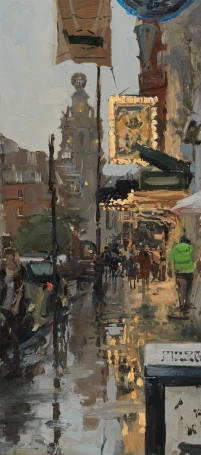
There's been a tremendous amount of rain this summer in London, and the same in most places in Britain I think. It's also been warm, and a lot of thunder and lightning. The rain has been very heavy on occasion though and I've got soaked through a few times outside.
Peter Brown's painting (right) was on display at the recent New English Art Club exhibition (just finished). It's called Saint Martin's Lane, Rain (oil, 48x25cm) and he gets the wet, grey atmosphere just right.
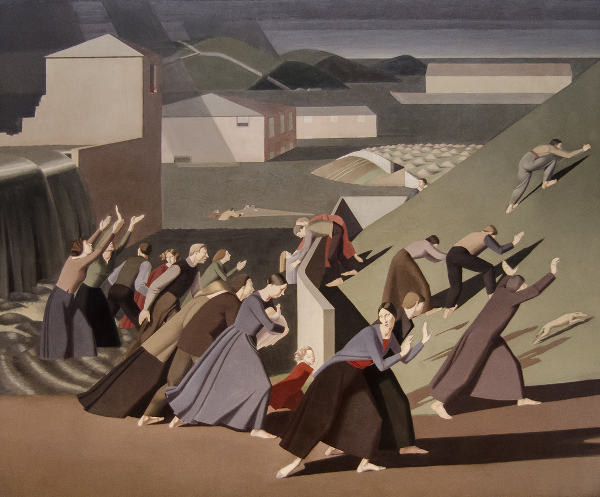
The Deluge is Winifred Knights' most famous painting: it usually hangs in The Tate and is a striking early 20th century "modernist" work. The British School in Rome awarded it the Scholarship in Decorative Painting in 1920, one of the prime movers in this award being the painter John Singer Sargent (one of the greatest ever artists).
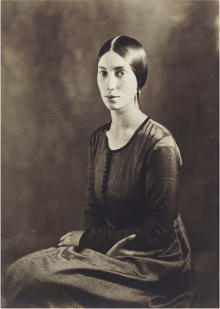
Dulwich Picture Gallery has an exhibition of her work at the moment and, although fairly small, it is possible to see a real growth in the quality of her work over her (few) years.She died in 1947, at the age of 48. not leaving a large body of work but some of the work she did leave is very good.
She has a web site.
The Dulwich Picture Gallery has a Winifred Knights exhibition on until 18 September 2016.
Below: Edge of Abruzzi, 1924, 68x68cm, Oil
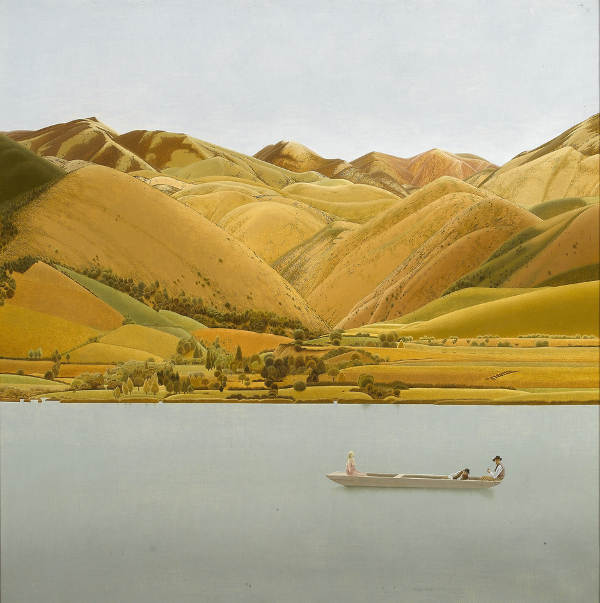
Below: Scenes from the Life of Saint Martin of Tours (Detail),
1928-1933, 73x159cm, Oil/Tempera
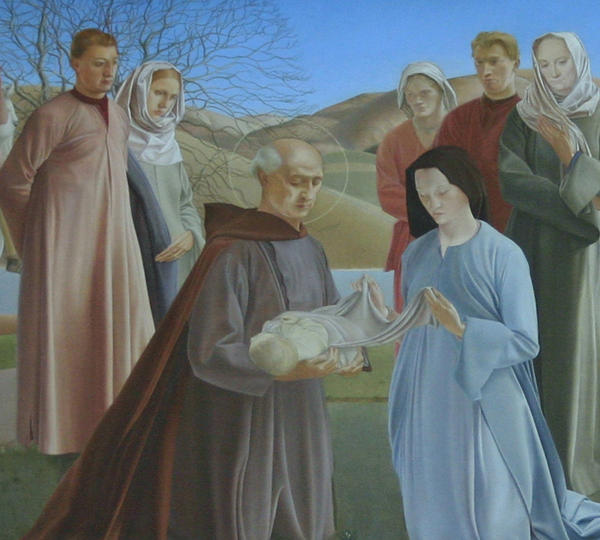
In the fifteenth book of Homer's Illiad, the goddess Hera flies across to Mount Olympus and the poet compares her to a particular movement of the human mind. When a man has travelled far and wide, he tells us, his mind will sometimes leap and he will think, "I wish I was here, or I wish I was there", as he "longs for many things". Hera's sideways flight is as swift as these inconsistent thoughts as she moves from the peak of one mountain to another.
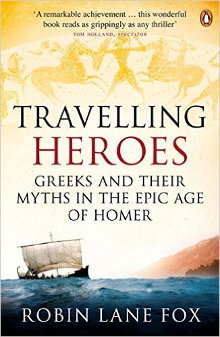
Robin Lane Fox's book Travelling Heroes has some poetic passages, including his opening paragraph above, but not enough to save it for me.
The book is a look at how myths travelled around the Mediterranean Sea with early Greek traders, pirates and mercenaries, primarily from the island of Euboea, off the Eastern coast of mainland Greece. The myths travelled with the people but the contact with the Near East, particularly the Phoenicians and Neo-Hittite people influenced and modified the tales. At some point in the 9th Century, some form of Greek/Phoenician meeting was the foundational cause of the Greeks regaining their lost literacy when the Phoenician alphabet crossed over. As you could say, the rest is history.
Although Homer is an anchor point in the text, much of the discussion is over what is missing in Homer's knowledge of people and places. The poet Hesiod, who is posited to have won a Euboean poetry competition in the 800's with his Theogony, is also much debated.
This book should have been something to treasure reading and exactly the sort of book I often love, but in the end there was too much plodding detail, particularly over the pottery, but even landscape and archaeology. Too much detail and not enough poetry.
I didn't know the BBC did a television program based on the book in 2013 but was pleasantly surprised. I decided to read the book first, then watched the program. Fox reminds me a little of Kenneth Clark in Civilisation as he potters around the Med, but the television was quite good, and a lot more succinct, as well as beautiful to look at in many parts. In this instance, I would recommend watching television over reading.
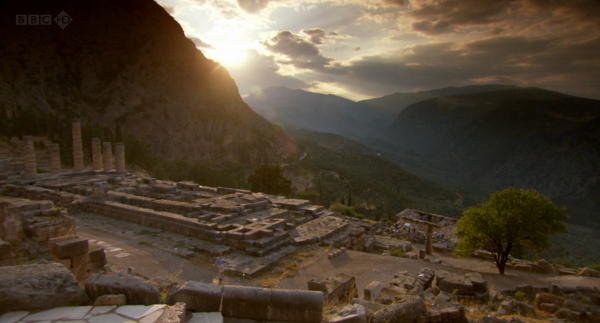
At the Mall Galleries for the 2016 New English Art Club exhibition. As usual, very good show and lots of great art. As I've got around, I know some of the artists better and recognise their work. Some styles grow on you. All for sale, if not sold, and some tempting work.
Here are a few I like (from many more).
Judith Gardner :

William Selby :

Haidee-Jo Summers :
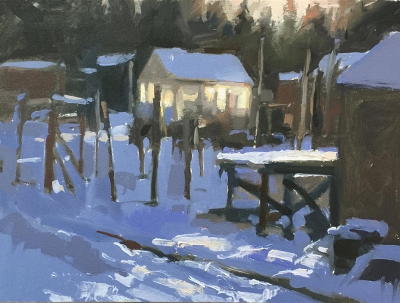

Above: A Dull Day, Sheringham Beach, Oil, 20x25cm
I am trying to keep the painting simple, but they all have their challenges.
Last September, I visited the little seaside town of Sheringham on the North Norfolk coast. It's almost my namesake, except I seem to have gained an "r" somewhere along the line. It's a lovely little place, though a little bit delapidated in places.
The painting ia based on a photograph I took, and it was a bit of a dull day so the picture reflects that somewhat. There was actually a rainbow over the sea but I was not going to include it because rainbows can make a picture look artificial (or worse). However, maybe it needs a bit of focus. So, rainbow or no rainbow? There's always the risk I ruin everything.

Sheringham Town
There's quite a bit of charm to the place, even though it has faded from its prime (a long time ago). A market on Saturday is supposed to be busy, and there seem to be a lot of places to eat and browse on the main street. Apparently a long fought battle to keep Tesco out was lost a while ago, but hopefully that doesn't mean the game's up and it's over for the town. Even without great weather, I like the seaside and the North Norfolk seaside at Sheringham is worth a visit, rainbows or not.
Below is a very idealised picture of The Roman Senate in 63 BC, as depicted by Cesare Maccari in 1889 (painted for the new Italian senate itself) :
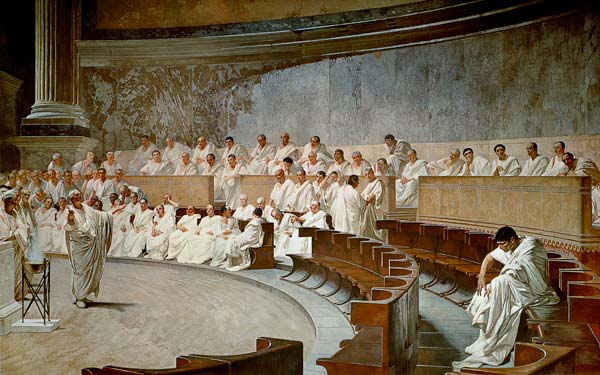
It's a famous picture and Mary Beard's new book SPQR (a link to The Economist review) begins with a description of one of the big crises of the later Roman Republic, the Catiline Conspiracy. In the painting, Marcus Tullius Cicero holds the floor denouncing fellow senator Lucius Sergius Catilina, the isolated figure in the bottom right. Catiline would soon realise that he was finished in Rome and his uprising (if that was what he planned) was stillborn; he would slip out of the city to die in battle at the head of his supporters. This episode was very famous in its day, and endlessly discussed (not least by Cicero himself) and Mary Beard uses it right at the start of her book to introduce some of the main elements of her history of Rome. The first century BC was tumultuous for the city.
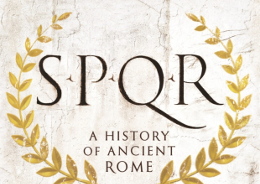
The recent BBC TV series Ultimate Rome is a companion to the book, and whereas the television is good, the book is excellent. Both tell the same story of the rise of the city and the background of its people, politics and culture. As one would expect, the book has a lot more detail and much greater depth. A greater depth but remaining very readable with lots of interesting and sometimes amusing anecdotes. One of those books that absorb and fly by so quickly because of their quality.
One of Beard's strengths, apart from having a very deep knowledge of her history, is the fact she can find and include so many small, often more personal, artifacts from the lives of roman citizens. These are sometimes grave inscriptions, perhaps a small message about a beloved son or daughter, or sometimes business signs. Even "pub" paintings.
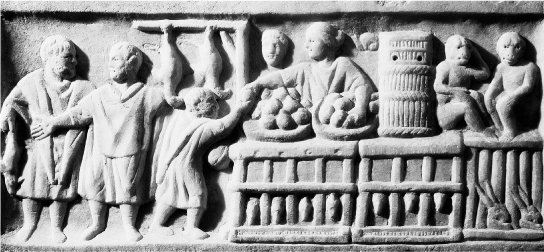
Above : A marble relief showing a poultry seller's stall from Ostia, perhaps from a tomb or perhaps a shop sign.
The man second from the left seems to be drumming up trade, and behind the counter a woman is serving customers. The stall is
constructed from cages (containing a couple of rabbits), on which a pair of monkeys sit.
Source.
Solitudinem Faciunt, Pacem Appellant
The famous phrase from Tacitus : They create desolation and call it peace.
In fact, the people the Romans conquered were often quite happy to collaborate in their subjection to Rome, many in the ruling or upper echelons being long used to the privileges and luxuries that came with civilisation. The "barbarians" wanted the "good life" as much as anyone. For most people (the vast majority were rural) life went on as usual. Beard has some more to say about native resistance in her blog A Don's Life.
Tacitus puts some fine words into the speeches of the far-flung "barbarian" rulers who all lost out, and usually lost their lives, to Roman arms. Fine words, but there was no way Tacitus knew what was said. As Beard points out though :
While we must regret not reading the authentic views of the provincial dissidents of the empire, the idea that Roman writers could imagine what it was like to be in opposition to their own imperial power is perhaps even more important, and it is a distinguishing feature of Roman culture and power.
Professor Beard closes with the year 212 AD and the Emperor Caracalla giving all freeborn inhabitants of the Roman Empire citizenship. People have argued about the reasons he did this for a long time, one common suggestion being that it massively expanded the tax base. At the end of the book, she tells us that she is not the person to finish the history, and write the story of the end of the Empire in the West, or its continuation in the East. A shame because it's a wonderful book and a second volume would be very welcome.
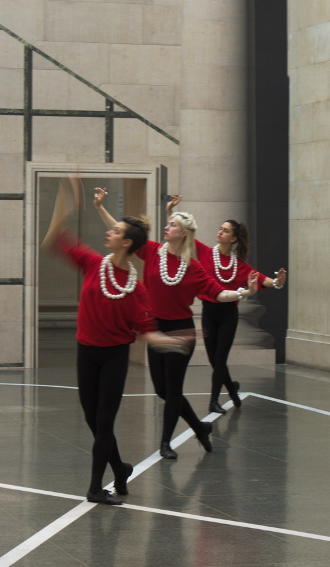
On the right, dancers in Tate Britain's Duveen Galleries today.
This is part of the 2016 Tate commission from Pablo Bronstein, a British/Argentinian artist who has an abiding interest in Baroque architecture and dance. He talks about this on the Tate site. His dance work is called Historical Dances in An Antique Setting.
The dancing will happen every day, all day, for six months and what I saw was silent, and a bit eerie. I didn't see any visitors join in but some children seemed to be tempted and there was a bit of bemusement in the audience.
And over in another room, American high school students and teacher sit and talk about a large Stanley Spencer painting, The Resurrection, Cookham. This made for some interesting listening, especially touching Spencer's slightly eccentric theology. Some would say all theology's slightly eccentric however. More about the work here.
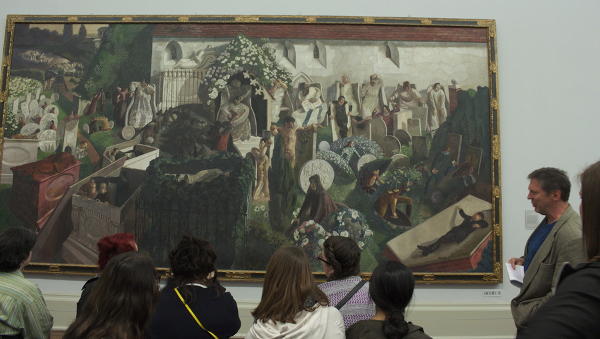
And, if you want modern, Tate Britain has modern, which includes some very odd stuff indeed if that's of interest. They are currently proud to welcome back Tracey Emin's bed, specially setup alongside some Francis Bacon.
Below, some modern art. At bottom, Nicholas Pope, Liar Liar :


The word "bemusement" came up earlier ...
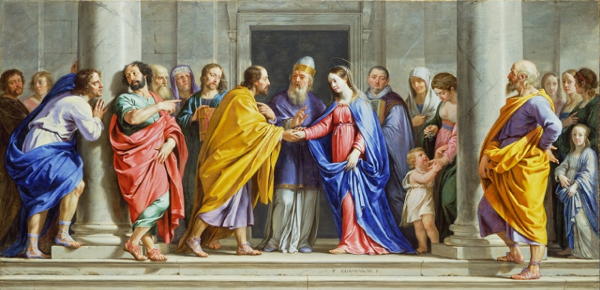
Above : The Marriage of the Virgin by Philippe de Champaigne (1644).
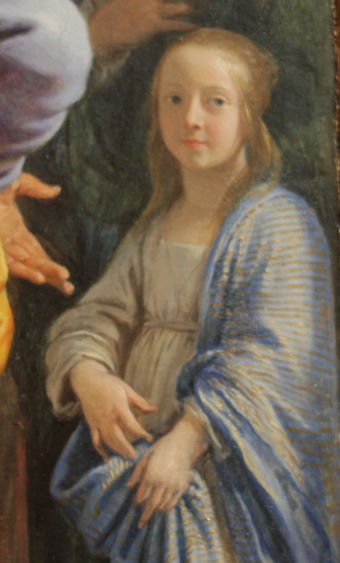
This is not a painting I would normally draw attention to, or blog about, although I like it. On display as part of The Wallace Collection, it is a bright and colourful picture of the marriage of Mary and Joseph. Actually, not something described in the bible but a story told in later apocryphal writing.
But the arresting image of the girl at the far right, staring straight out at the viewer, always made me stop and wonder. Obviously someone of particular importance to the artist, and in this case, it turns out it is probably his daughter Catherine. Small details like this that pop up on occasion enliven one's interest and remind us of the human being being the art, even if long dead.
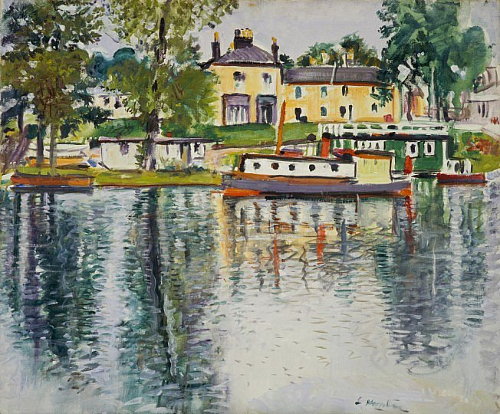
Above :Reflections, Balloch by George Leslie Hunter. Oil. 1920-1930.
This painting caught my eye at the Scottish National Gallery of Modern Art last year. A lovely bright and colourful picture of the village of Balloch, at the southern end of Loch Lomond. George Leslie Hunter was a Scottish painter of the early twentieth century, a member of the "Scottish Colourist" group of artists. From the gallery site :
After spending time on the continent, Hunter had lightened his palette in response to the strong Mediterranean light, and his handling of paint had become bolder and more fluent.
The palette and light give the scottish scene a definite south of France feel (he must have been lucky with the weather). For a good overview of Hunter's life and work, I came across a very good blog post at My Daily Art Display.
I love browsing around the British Museum, especially some of the old "Greek" stuff they have. Not that "Greece" existed back then and not that you could really call the people making this stuff "Greek" really. Some of the early Aegean "Cycladic" artifacts caught my eye and looked interesting enough to file away as a possible artistic reference. I actually got around to painting one this time.
The result is below. A lot easier to paint than the last one I did, and pretty quick; other than having to wait a few days for some of the jug's body to dry before finishing. I'm happy with the result anyway. As I said, a lot simpler to do than last time, and more successful I think.
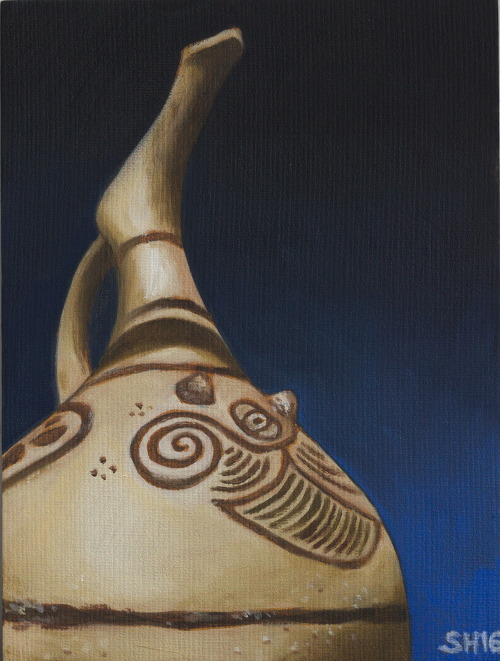
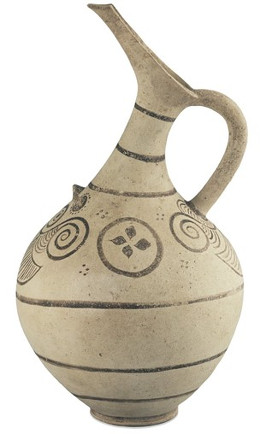
The museum description is :
High spouted jug with two nipples in relief and dark decoration on a white background. Middle Cycladic , 1800-1550 BC. Perhaps from Melos.
A link to the item itself and, on the right, the real thing.
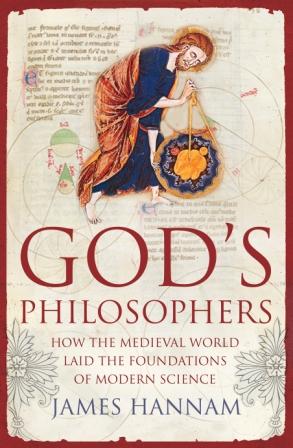
The Middle Ages gets a bad reputation but in many respects this is unfair and completely unwarranted. It turns out that a lot of the criticism and misconception is because later ages just didn't know the debt they owed to some of the great thinkers of the past. In some cases, people had their own axes to grind. James Hannam's book God's Philosophers tries to set the record straight.
In one chapter, Hannam looks at the medieval university and its syllabus, including the trivium (grammar, dialectic and rhetoric) and then the quadrivium (arithmetic, geometry, music and astronomy). The trivium is the origin of our word trivial, but is far from the easy subjects the word means today.
One of the most famous phrases meant to trivialise so much of medieval learning is the question of how many angels can fit on the head of a pin.
Modern critics of medieval universities have accused them of concentrating too much on useless and obscure logic at the expense of real knowledge. Logic was certainly an important part of the syllabus and it became increasingly complicated through the later Middle Ages. As an intellectual exercise, scholars would invent absurd situations and try to reason their way out of them. Every now and again, the universities would host a special session where students could put their fiendishly difficult questions to a senior professor. No doubt they went to considerable trouble to to come up with the most convoluted riddles they could think of in order to tax the minds of their superiors. The professor gained a chance to show off his mental dexterity by dealing elegantly with whatever his students threw at him. The result was a very rarified form of intellectual entertainment. Questions preserved for posterity include "Should a person born with two heads be baptised as one person or two?" and "Can a bishop who is raised from the dead return to his office?" Even Thomas Aquinas had had to find an answer to the question "Is it better for a crusader to die on the way to the Holy Land or on the way back?" The medieval logical conundrum that everybody knows is "How many angels can dance of the head of a pin?" Sadly, this turns out to be the invention of a seventeenth-century Cambridge academic satirising the admittedly rather abstruse theology of Thomas Aquinas. If a medieval scholar had really asked this, he would have meant it as a joke.
The book isn't long and not hard to read. It is a good reminder that every age has its clever people writing and thinking interesting things, even if they're not as "knowledgeable" as we might be today.
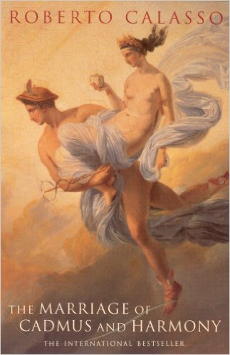
The Marriage of Cadmus and Harmony
By Roberto Calasso
These things never happened, but are always.
Sallust. Of Gods and of the World
But how did it all begin? On a beach in Sidon, Europa is enchanted by a bull.
Calasso's book is one of the most beautifully written, and most poetic prose books I've read. He tells the various intersecting stories of the Greek Olympian Gods in a way that brings a fresh perspective on their lives and loves. These stories of Gods, Goddesses, Titans, Heroes and Humans are from a long lost world before history started.
We shouldn't be to concerned about having lost many of the secrets of the myths, although we must learn to sense their absence, the vastness of what remains undeciphered.
This is a wonderful book but on my second reading, I had forgotten about how impenetrable some of it was. Beautiful to read, but sometimes difficult to understand. With that said, the attempt and the journey through the words are always rewarding though.
I only noticed this second time that the translator is Tim Parks, a British writer living in Italy. I've read and liked him in the past. The poetry of the Marriage of Cadmus and Harmony must also be down to Parks' great translation.
This is a photograph of an artwork called Aggregation10-SEO32RED by Chun Kwang-Young from Korea, as seen at the V&A Museum :
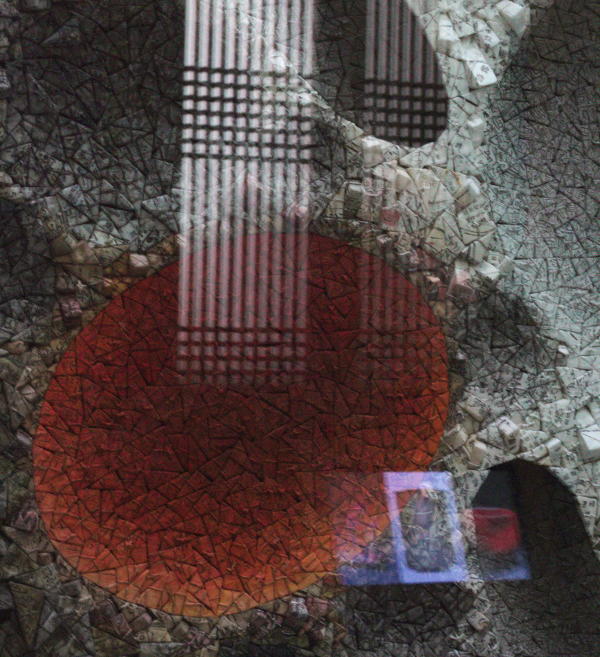
Ignoring the reflections on the glass, what I liked was the stark and sombre contrast between the grey and the red. There's something volcanic to it.
The description says that the work is created by wrapping small pieces of styrofoam in Korean Hanji paper, a very common and long used type of paper (they are very proud of). We are told that the cracks and defects :
.. symbolise the difficult history of Korea, but the strong paper reflects the resilience of the Korean people.
A grainy close-up :
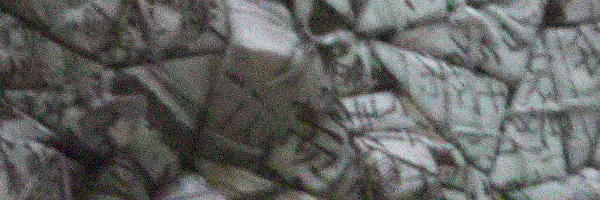
The Koreans living in the North certainly need all the strength and resilience they can muster. An interesting and arresting creation (and well displayed).
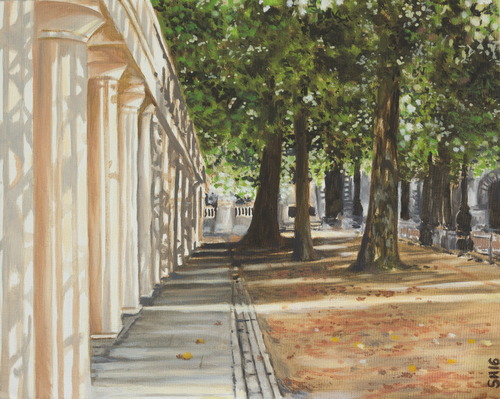
This painting is from a photograph I took a year or so ago: a bright sunny day on The Mall in London. This was looking towards the Mall Galleries and I liked the dappled light falling through the trees and onto the marble columns. The painting has not turned out as well as I wanted, but that might be the usual state of affairs! Maybe I bit off a bit too much. Having said that, it finished better than it looked when half completed, and I might learn to like it more, which sometimes happens.
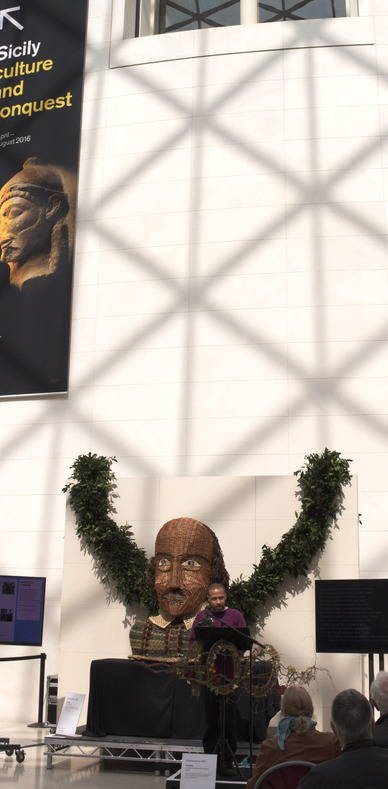
It is 400 years ago that Shakespeare died (on April 23rd 1616) and there has been plenty of things to see and do to celebrate the Bard, including at the British Museum. Here, an all-day Sonnetathon from Poet in the City, with actors and performers reading a seelction of sonnets throughout the day in the Great Court.
Great idea, but unfortunately the acoustics did not seem to work too well in the space and I found it fairly hard to hear the words.
I was passing through on my way up the stairs to the left, and to the new Sicily Culture and Conquest exhibition. Hopefully more about this later but initial impression is that it was very good and just the sort of show I like. Definitely more visits to come.
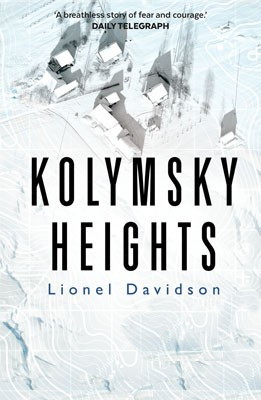
Kolymsky Heights
By Lionel Davidson
Jean-Baptiste Porteur, or Johnny Porter, is a Gitksan Indian from British Columbia, a member of the Raven clan. He is a prodigy with language, cautious, taciturn, extremely resourceful and clever. Tricky. A perfect secret agent for a very particular job.
This was an amazingly good read. Well written, exciting and another excellent thriller from Davidson. This is the second book of his I have read, after The Rose of Tibet, and on this form I will be reading many more. Kolymsky Heights is not only exciting, it is full of detail of language, landscape and life in the Artic, especially the natives of Northern and Eastern Russia, people I had never heard of. Like all great novels, you learn a great deal as you enjoy the read. Like Philip Pullman's review: the best thriller I've read.
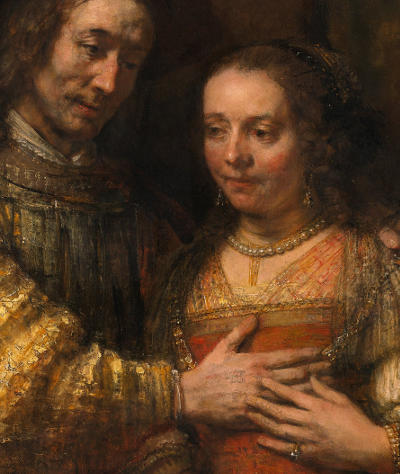
On the right, a detaill of Rembrandt's The Jewish Bride, a late masterpiece painted around 1667.
In the recent BBC4 Television program Schama on Rembrandt , Simon Schama calls this "the painting of love". It is a very beautiful and tender picture and another very good documentary from the BBC. Fittingly, for one of the greatest artists ever.
I was lucky enough to see this and many other pictures at the National Gallery a year or so ago, at their Late Works exhibition.
The Royal Academy is posh and a bit more expensive than many places, but they definitely know how to put on a good show. This one is extremely good, and no surprise it is very popular. On Easter Sunday I visited Painting the Modern Garden.
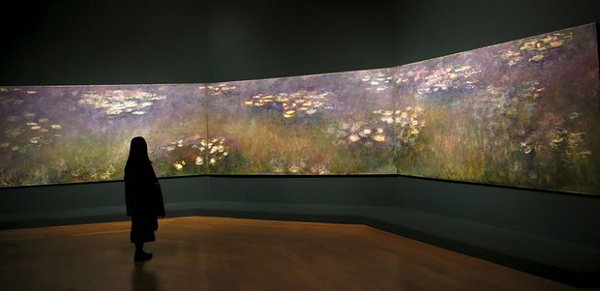
Every room was stunning, and there are a lot of rooms and a large space. Because the entrance to the show was busy (they often act as bottlenecks), I decided to make my way to the last room, sweeping through the first few and getting a brief snapshot of everything. From the end, I worked backwards: not always ideal in an art exhibition, but not a big issue with this one I think. So I started with the rare sight (outside France) of Monet's amazing water lilies, three of the large canvases side by side.
But there is a lot more than Monet in a very well thought out and presented exhibition, including many artists I had never heard of, like Santiago Rusiñol and Henri Le Sidanier, to name only two of note.
The subdued lighting of the room named Gardens of Silence made Rusiñol's Glorieta stand out as if on fire, as it almost glowed. One almost needed to give all the paintings a great reverence.
 Above: Glorieta De Cipreses-jardines Aranjuez, Santiago Rusiñol
Above: Glorieta De Cipreses-jardines Aranjuez, Santiago Rusiñol
Le Sidanier's paintings had a beautiful and ethereal quality to them. Another artist I need to look out for.
 Above: Steps, Gerberoy, Henri Le Sidanier
Above: Steps, Gerberoy, Henri Le Sidanier
I knew to expect a crowd because I had seen it when I was here a few weeks ago for the Giorgione exhibition upstairs. I also saw how far ahead you had to book to get a ticket at a decent time. This was definitely worth the wait
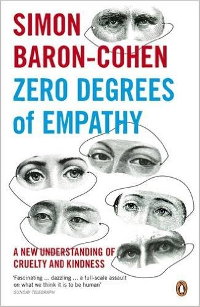
Zero Degrees of Empathy
By Simon Baron-Cohen
Simon Baron-Cohen is a Professor of Developmental Psychopathology at the University of Cambridge. His main areas of research are autism and empathy. I have just finished reading his new book Zero Degrees of Empathy.
I read a good book a year or so ago by the author (and another Professor) Adrian Raine, a book called The Anatomy of Violence, and I saw Raine's name come up here. Raine looks at the causes of criminality, and particularly violent crime: how much is genetic, how much environmental. Baron-Cohen's new book is a look at the causes of cruelty, and the nature of evil. Rightly, he sees the word "evil" as unscientific and wants to bring some scientific rigour to it. He posits that cruelty and violence is related to how much empathy you have (a measurable empathy quotient). He outlines this theory and looks for causes.
Baron-Cohen takes some time to investigate some case studies and looks at the background of people with some severe behavioural or personality disorders. The final analysis finds multiple reasons some people end up with problems and, as one would expect, there is a partly environmental as well as partly genetic cause. The following passage is one that struck me as I leafed through the book in the bookshop, and is partly responsible for the purchase. On bringing up children :
What the caregiver gives his or her child in those first few critical years is like an internal pot of gold. The idea - which builds on Freud's insight - is that what a parent can give his or her child by way of filling the child up with positive emotions is a gift more precious than anything material. That internal pot of gold is something the child can carry throughout their life, even if they become a penniless refugee or are beset by other challenges. The internal pot of gold is what gives the individual the strength to deal with challenges, the ability to bounce back from setbacks, and the ability to show affection and enjoy intimacy with others, in other relationships. It overlaps with what London child psychiatrist Michael Rutter refers to as "resilience".
This "internal pot of gold" is a very powerful description of what good parenting can do for a child. This is a brief but worthwhie read.
This is a small painting I did at the weekend :

Above: Venice Light. Oil. 18x13cm. After Christopher Miers.
The above is a copy of a painting by Christopher Miers, Late Afternoon Light, Venice and is a very impressionistic piece of work. His paintings (see his web site) are often quite simple but very effective. I like them.
I saw Miers' painting at the RBA show this year and I liked its simplicity immediately. In fact, I thought it was simple enough for me to have a go myself. I only spent about 40 minutes on it, painting it in one go.
The original :
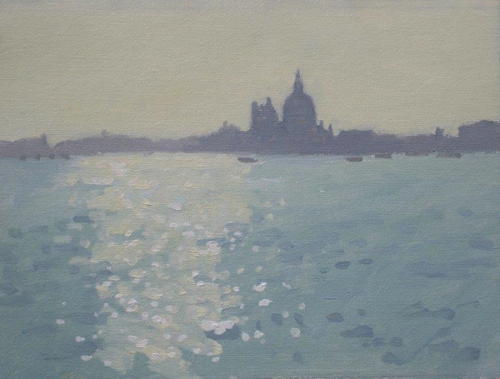
Late Afternoon Light, Venice, by Christopher Miers
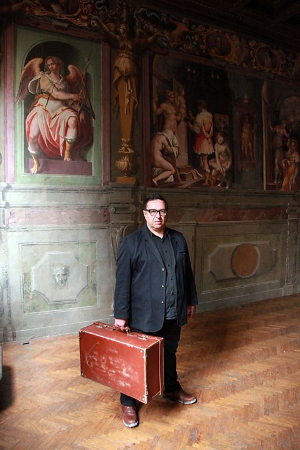
Waldemar Januszczak is an acquired taste as a broadcaster, there's something of the wideboy about him: the brash Londoner. However, stick with him because he's created two very good BBC Television series about art.
Firstly, his series on the Impressionists showed more of the art and the background than I've seen before. I learned new and interesting details that made things fresh again, including learning of an artist I hadn't heard of before: Gustave Caillebotte. More recently, his Renaissance Unchained series has covered the expected (Michelangelo, Leonardo, Durer) but also the more unexpected, such as St George and the Dragon by Bernt Notke or the Compianto sul Cristo morto by Niccolo dell'Arca.
From the beginning, Januszczak posits that Vasari, author of the famous Lives of the Artists, was less than fair with the Northern masters, precursors of the new artistic rebirth in the 15th Century. Artists like Jan Van Eyck, Hans Memling, Rogier van der Weyden and Hieronymus Bosch. A bit like a football fan, Vasari, from Florence, was "rooting for the home team" a bit perhaps. There is a compelling argument to be made here: Italy did reach the pinnacle of artistic achievement of course, but the Northern Renaissance also happened. Waldemar Januszczak attempts to redress this a little and made four very good programs, well worth catching.
And if anyone is wondering about what they might be missing, not having heard of Niccolo dell'Arca or Bernt Notke, take a look. The Lamentation over the Dead Christ is especially powerful and must contain some of the most powerful and emotionally charged figures I have ever seen. More here.
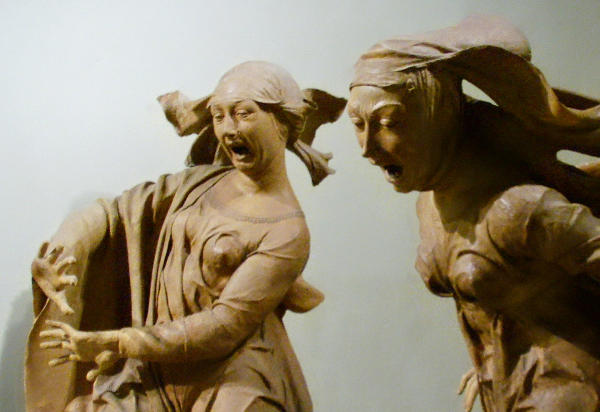
Niccolò dell'arca, Compianto sul Cristo morto (detail), Terracotta. 1460's. Bologna
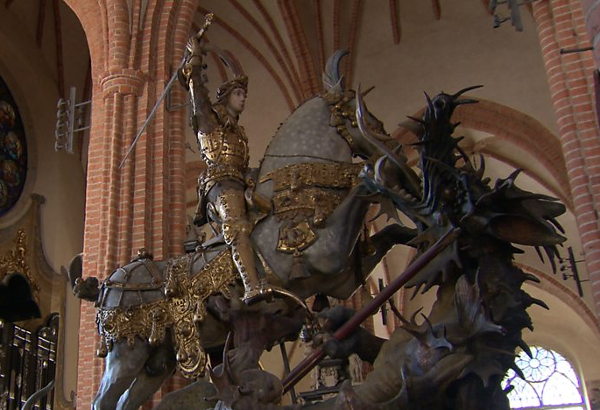
St. George and the Dragon, Bernt Notke. Storkyrkan, Stockholm. 1470's.

Above: Bowls by a Window, 20x20cm. Oil.
A new painting.
It did not turn out quite the way I wanted, but I'm fairly happy. I got the colour wrong for the bowls but decided to "fix" it once touch-dry with a glaze. Still not quite right but acceptable. There are other things wrong, but I won't dwell on it. I like the light and the wood texture.
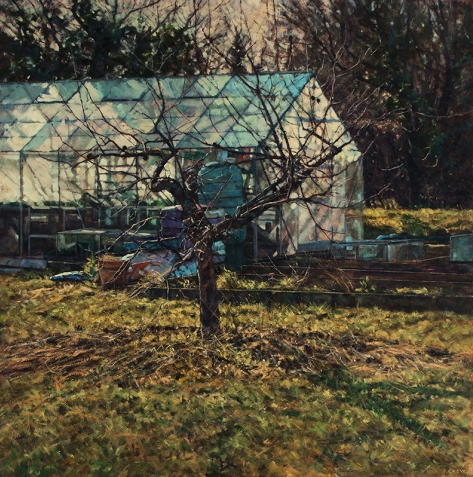
Above: Morning Light, by Rowan Crew. Oil
Seen and liked at the Royal Society of British Artists 2016 exhibition at the Mall Galleries.
There were lots of other ones I liked, including all the Nicholas Verrall. One of them :
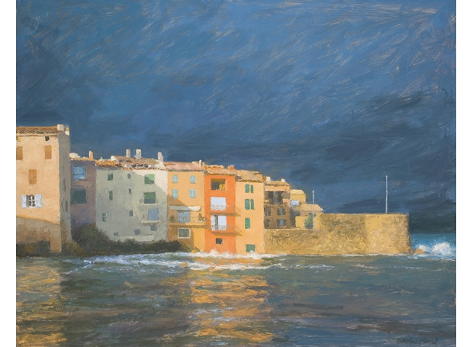
Bay of St Tropez, by Nicholas Verrall
The Verrall is 61 x 74 cm. And for real simplicity, but very effective, what about this one at 28 x 33mm :
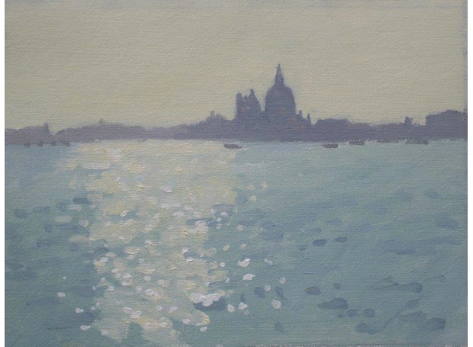
Late Afternoon Light, Venice, by Christopher Miers
See lots of others here.
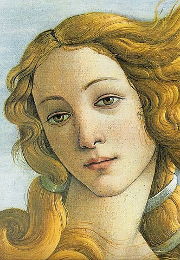
Walking into the first room of the Botticelli Reimagined exhibition at the Victoria and Albert Museum and looking around had me slightly worried. Worried that the show was going to be too much pop, fashion or superficial kitsch. I'm just not very enamoured with David LaChapelle's day-glo style or performance artist Orlan.
Then I came face to face with a surprise tucked around the corner : a piece of art that I really loved when I first came across it a year or so ago. This is the Donghi (see below). From here on, things picked up for me. On to room two and a lot of interesting paintings, most from the 19th Century (and many Pre-Raphaelite). Then, room three and we finally come to some real Botticelli work (as well as many "workshop of"). Even Botticelli drawings of Dante, something you can also catch at the Courtauld just now, and something I wrote about recently.
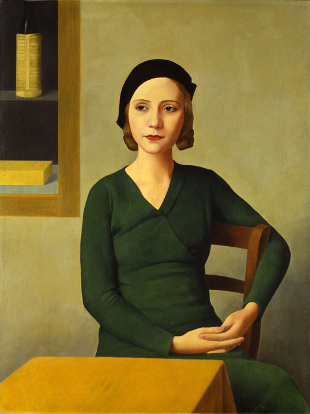
The Donghi painting impressed me a year or so ago when it appeared in a Guardian piece. What a surprise to see it in real life. It still impresses me with its clean lines and colour, although how much influence Venus had on it is probably very debatable. Then again, there were quite a few tenuous links made throughout the exhibition.
On the right: Woman at the Cafe, Antonio Donghi, 1932
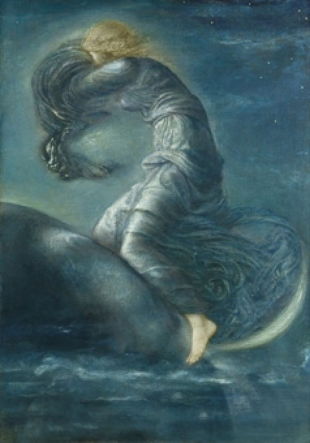
Room two had many paintings I liked, including a few Rossetti, Burne-Jones and a large tapestry by William Morris called The Orchard.
On the right: Luna, by Edward Burne-Jones.
Luna is a beautiful and atmospheric painting, one of a series of allegorical female figures Burne-Jones completed in the 1870's. According to a Christies page, this was previously owned by Yves St Laurent (who seems to have had very good taste in art if you glance through the sale catalog).
Below : The Orchard by William Morris and John Henry Dearl. About 1863
The Orchard is a large (wall size) tapestry showing fruit trees ready to harvest and women holding a poem of Morris' own composition. Again, perhaps only peripherally related to Botticelli's Venus, but looking up at this and the others, who cares?
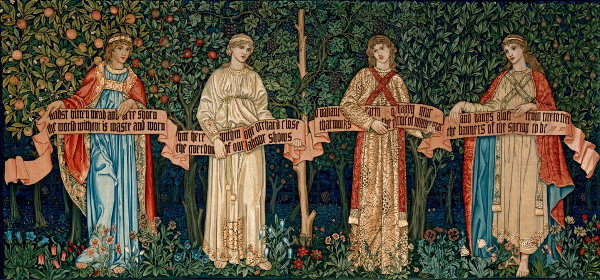
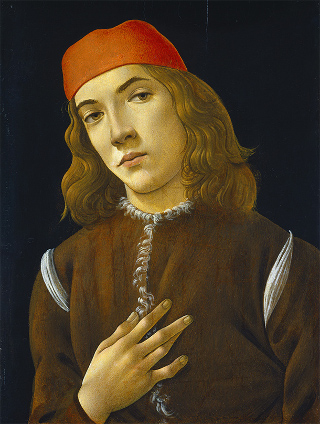
The last room is devoted to work from Botticelli's time, including many from his workshop. Some would have had input from him, but others perhaps not and the quality is variable. There were too many Madonna and Child for instance, and a few were not so good (not true Botticelli, I hasten to add). It does highlight his mastery when we see it though. Unfortunately, no actual Birth of Venus (it never leaves the The Uffizi), but some good pieces.
On the right: Portrait of a Young Man, c.1480-5 by Sandro Botticelli
It's a lovely museum and a really good exhibition. One I'll try to visit again.
On the right is a painting called The Cowgate, by Henry Kondracki.
People familiar with Edinburgh will recognise the location. Kondracki captures the ambience of a cold, snowy dusk very well, especially the tire tracks in the snow and the warm light thrown out by shops and windows. It takes me back to the time I lived up there and I might be hurrying up to the Bridges to catch a bus home (I can see the condensation on the windows and even hear the bus window wipers going). Not so good for cycling though, not just the weather but too many cobbled streets!
This picture won first prize at the Lynn Painter-Stainers Show for 2016.

Two Apples, Oil, 20x20cm
I was very pleased with the way this came out. It was also the first time I did some glazing. Glazing is using a transparent layer on top of a base colour and it is a way of deepening and enhancing the way the colour appears. I only needed a little for the brownish colour on the sides of the apples but it had to be quite subtle. I waited two weeks to be sure the paint was properly touch dry and took care but I think it worked very well.
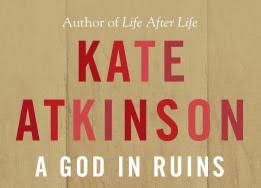
A God in Ruins, by Kate Atkinson
A God In Ruins is Kate Atkinson's follow up ("companion") to her highly praised (not least by me) novel Life After Life.
This is a very good novel but I don't think it is as good as Life After Life : but that's a very high bar.We follow the life of Ursula Todd's much loved brother Teddy through his Second World War experience as a bomber pilot and on to marriage, parenthood and old age. The story is told in a non-sequential way, jumping backwards and forwards through time, visiting various points of the characters' lives. We see through the eyes of Teddy himself, Nancy (his childhood sweetheart and wife), Viola, their daughter, and his grandchildren. There is less "magic" here but this is because so much was sucked out of the world by the second big war (as much a continuation of the first really).
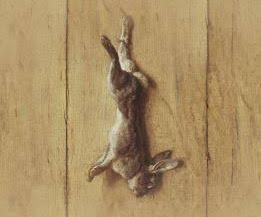
There are many beautiful moments, moving and thoughtful, some very funny but also some darker and more terrifying, as we experience what is was like to pilot a bomber over Nazi occupied Europe. As well as raining a terrible death and destruction over Germany, creating an inferno as the war reached its climax, most of the air crew were very young, and many never came back. Atkinson is very good on the human face to war. But as well as this tragic destruction of human life and European civilisation, the aftermath of the war is a heavy weight on survivors; we see this through the generations.
I like these two books for the evocation of the pre-war world for the Todd's at Fox Corner, their house: comfortable family life, nature, dogs and poetry. A vanished world. And then the attempt to understand how the country turns out once much is swept away by the war. People are not so easily regenerated compared to the physical world. People forget, and want to forget, or perhaps never want to know. Uncomfortable reading sometimes, but worth it.

This server runs Debian Linux, and I've been running version 6 (Squeeze) for a long time. Squeeze was the first "LTS" release supported by Debian.
LTS stands for "Long Term Support" and is a tag used to denote longer than normal security updates and support. Well, we ran out of "long term" this week so I had to upgrade. Always a slightly worrying process on a live server but a quick hop-skip-and-a-dist-upgrade, it appears to have worked. Debian is one of the few computer operating systems that support OS upgrades without requiring a reinstall and it's a wonderful thing.
The only thing I have seen wrong afterwards so far is the calendar plugin for my blogging software (blosxom) : it broke with a Perl Storable byte-order issue. Easy to fix (at least temporarily) by disabling caching. Of course, I'll need to monitor it a bit more closely over the next day or so.
Hail Debian ;-)

The Stanwick Horse Mask is on show at the National Museum of Scotland in the Celts exhibition. I saw it at the British Museum and settled on it as a subject for a test painting. I need a lot of practice ... I am happy enough with it but only so far. More practice definitely required!
Right: Stanwick Horse Mask, Oil, 178x127mm
Note that this is not really a "mask" but an ornament attached to some sort of container or bucket, perhaps for ale. It is not very big (only about 10cm tall) but has a cartoon quality, well expressing the horse with an economy of style in the copper alloy. Probably from about 50 AD and dug up in Stanwick, North Yorkshire, in 1843. Details.
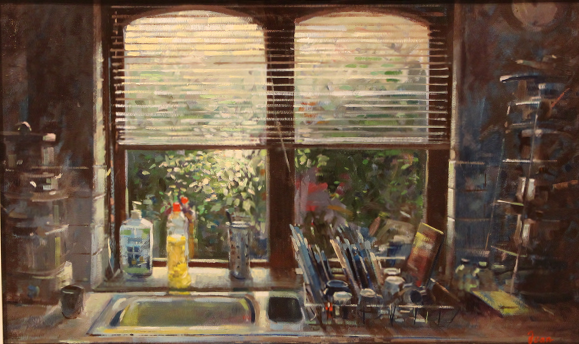
Everything and the Kitchen Sink, Bill Dean ROI WGA, Oil
As seen at the Mall Galleries Royal Institute of Oil Painters last December. Looking back, some amazing works shown.
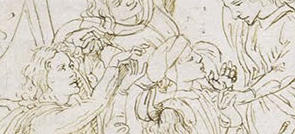

At the mid-point of the path through life, I found
Myself lost in a wood so dark, the way
Ahead was blotted out.
The Courtauld are showing Botticelli's drawings of Dante's Divine Comedy, and they're very good.
These drawings were part of a whole collection sold by the 12th Duke of Hamilton to the Berlin Kupferstichkabinet museum in 1882 to cover his gambling debts: a real loss many people tried to prevent at the time.
Showing thirty illustrations, drawn in silverpoint, pen and ink between 1480-1495, they are beautifully detailed and realised pieces. The number of figures drawn and the detail is remarkable: more remarkable if you pick up one of the free magnifying glasses available, which I thoroughly recommend.
Not just hell, but purgatory and paradise are present, with Botticelli seemingly having a lot of fun drawing some of the grotesque devils and torments in Dante's classic. Amazing work.
Botticelli and Treasures from the Hamilton Collection is on at The Courtauld Gallery until May 15th 2016.

-small.jpg)

I was very sorry to read about the death of the great Italian author Umberto Eco on Friday. I was only looking at his new novel Numero Zero the other day and adding it to my list of books I want to read. I loved The Name of the Rose, and every year I tell myself that I need to re-read Foucault’s Pendulum, something I read a long time ago and found both hugely enjoyable and mysterious. It is so rare that an intellectual Italian like Eco can cross-over into the mainstream Anglophone book world (let alone mainstream Italian book world). His death is a big loss.

I've been wanting to do this post for quite a while, but it's been one of those that has proved harder to write, wanting to do it justice.
The concept of "who, where and what" with the "Celts" can get both muddy and contentious today because it's mixed up with very modern notions of nation and nationalism, something the Iron Age tribes themselves pre-date of course. The British Museum and the National Museum of Scotland do a good job however, and try to put some context to the archaeology.
The exhibition Celts: Art and Identity has now left the British Museum and is off to Edinburgh's National Museum of Scotland. If you're in Edinburgh or environs, you should definitely have a look (it starts March 10th).
There was a lot to like, particularly the first half dealing with the ancient origins and archaeology. Some of the exhibits are familiar, such as the "Great Torc" from the Snettisham Hoard, something I've written about before.
Perhaps my favourite items on display are the Gundestrup Cauldron and the Braganza Brooch.
Gundestrup Cauldron
The Gundestrup Cauldron was dug out of a peat bog in Jutland, Northern Denmark, in 1891. It is the star attraction of the Danish National Museum in Copenhagen and a very sought after loan. You can see why :
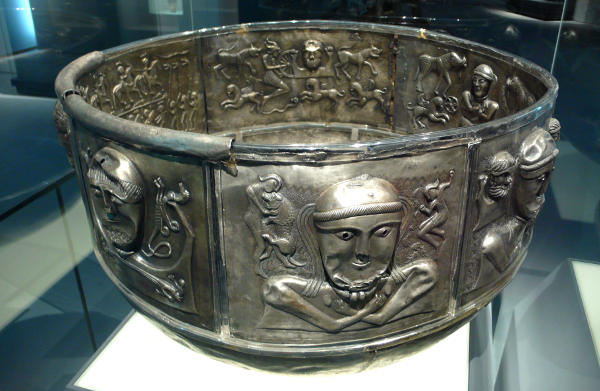
This is a very strange work in some ways, and found a long way from the usual "Celtic" areas of Europe. Although it has some Celtic elements (e.g. figures wear a torc, some are blowing the carnyx, a horn-like instrument), others are harder to explain as "Celtic". It is far from the usual swirling, organic Celtic forms.
Some parts of it seem almost shamanic, such as the antered figure hammered out of the silver on an inside panel :
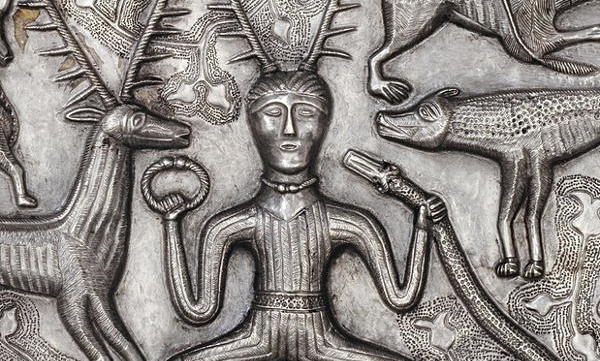
Where was the cauldron made? No one is sure, but some people posit Thrace, an ancient land now covered by much of modern Bulgaria and European Turkey.
Braganza Brooch
The Braganza Brooch is much smaller but just as beautiful. It only measures about 14 cm long, 5 cm high. Made of gold and some glass, it shows a naked warrior with a celtic style helmet, a sword and a dog (or dragon?) jumping up at him, with his shield pressed up anb blocking the beast.
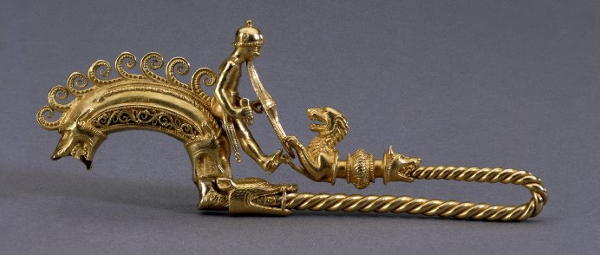
It has exquisite detail and workmanship :
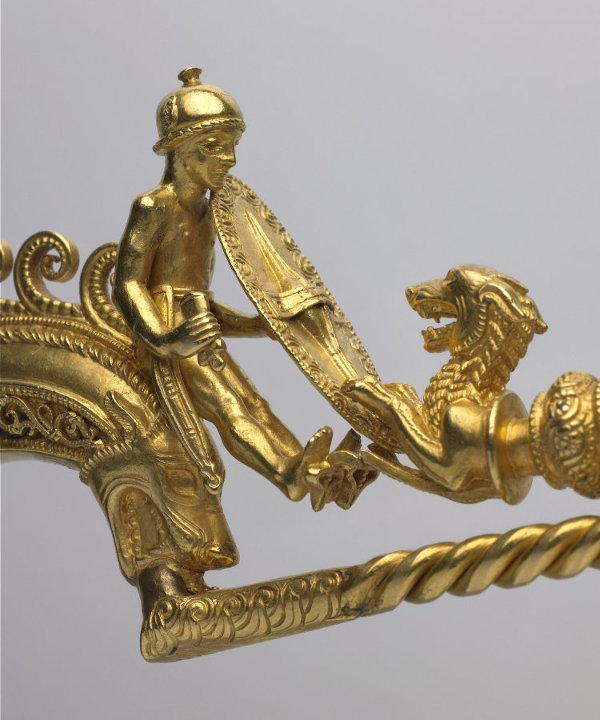
For more detail and background on the brooch, see The History of the Braganza Gold Brooch.
Overall, well worth a visit for many very interesting things in addition to cauldrons and brooches. There's a full size reproduction of a Celtic chariot, the Battersea Shield and even some Phoebe Anna Traquair, someone with some impressive artifacts in Edinburgh that I've written about before.
Nikolai Astrup has some beautiful paintings on show at Dulwich just now. Colourful and magical evocations of life in the Norwegian countryside in the early 20th century. The love he shows for his landscape, people and customs is palpable, which makes the work he produced in his short life very special.
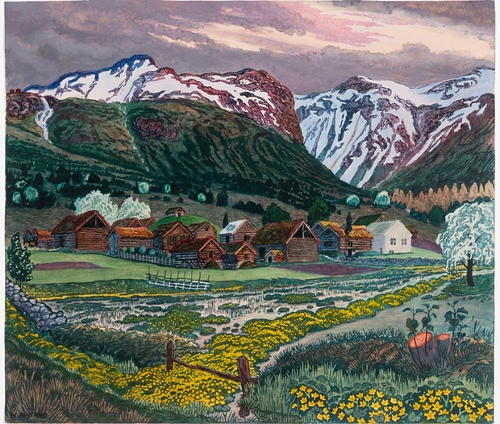
Marsh Marigold Night, c 1915
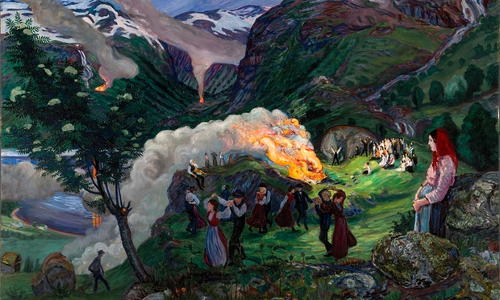
Midsummer Eve Bonfire, before 1915
Astrup hardly moved from his place of birth, living in the same village or not far away, all his life. He documented the village, the village folk, the garden and the landscape he could see from his window. He was only 48 years old when he died and an early picture of his shows a village funeral. It would have been almost exactly the same as his own twenty years or so later.
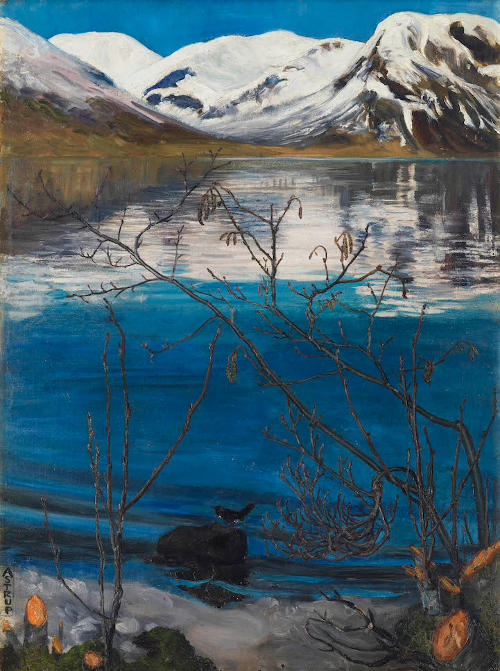
March Atmosphere at Jølstravatnet, Before 1908
You can see some more at the Dulwich Picture Gallery site. Another good web site to visit is here and The Guardian has a good write up. Better still, go to the exhibition.
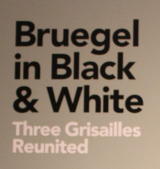
The Courtauld Gallery has a small Bruegel exhibition showing three of his very rare grisaille paintings side by side. The gallery is also displaying other Bruegel drawings in the collection, along with copies and some fakes (good drawings, but made to deceive).
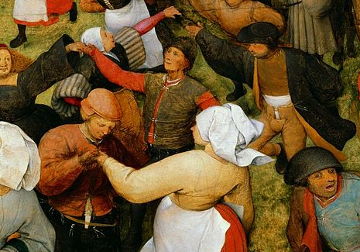
The Wedding Dance (detail), Pieter Bruegel the Elder, c. 1566
We have to be careful we know which Bruegel we are talking about because there are a few in the family, all artists. The one doing the grisaille is Pieter Bruegel the Elder, famous for his "peasant" scenes: idiosyncratic and often charming (see right). He had two sons, Pieter Brueghel the Younger and Jan Brueghel the Elder, with Peiter spending most of his artistic life copying his father, whilst Jan did a lot of still-life and landscape painting (and sometimes collaborated with Rubens, another artist well represented at The Courtauld).
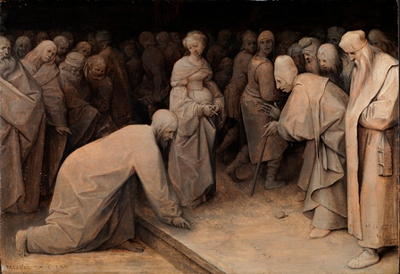
Christ and the Woman Taken in Adultery,
Pieter Bruegel the Elder, 1565
A grisaille is a black and white painting (perhaps with some umber as well) often thought to be used as a preliminary underpainting for a finished work in full colour oil. His Christ and the Woman Taken in Adultery was highly praised, and a picture he like so much that he never parted with it.
One of the things I noticed this visit was how good the Tiepolo San Pascual oil sketches are. In the early 1770's, Giovanni Battista Tiepolo was in Madrid and commissioned by King Charles III of Spain to paint some altarpieces for the church of San Pascual in Aranjuez. Apparently, the King was not impressed with the finished works and they were removed from the church and lost or destroyed (horrendous to think of the loss now). The surviving sketches are wonderful though.
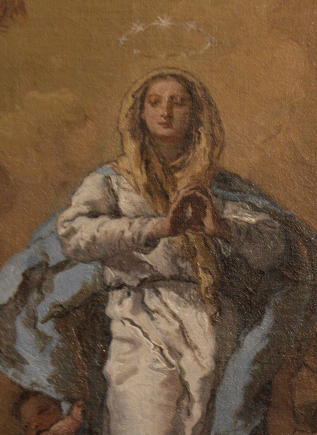
Shown below is the Immaculate Conception of 1767. Size is 60 x 40 cm (roughly), so fairly small (On the right is a close-up). The style is fluid and accomplished, quite modern and beautiful.
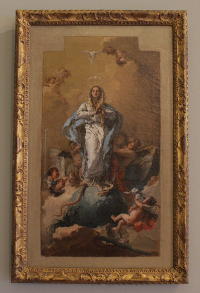
The picture on the right is a drawing by Kelvin Okafor called Jasmins Interlude. I came across this at the Mall Galleries on Saturday morning in the Columbia Threadneedle Prize Show
Visitors can vote for their favourite piece and I had 3 or 4 in mind, but I ended up casting my vote for this. It really stopped me in my tracks when I first saw it. Extremely realistic and drawn with a supreme level of drawing skill. Quite amazing.Okafor is a British artist (of Nigerian descent) with a website and blog. You can see him at work in a long sequence of photographs there. Very meticulous and fine work.
Right: Kelvin Okafor, Jasmins Interlude, Graphite and charcoal, 74 x 55 cm
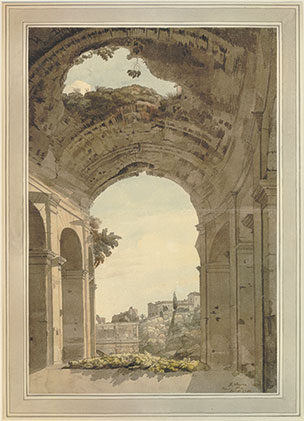
Above: Inside the Colosseum, 1780.
Watercolour with pen and ink
The British Museum have a free exhibition just now called Light, time, legacy. Running in Room 90, part of the prints and drawing collection, it displays the watercolours Francis Towne painted in Rome and Italy during his tour in 1780 and 1781.
It is always quite surprising to see how empty and overgrown Rome was in the 18th and 19th Centuries : a lot of the monumental stone work was ruined, a lot of the city abandoned by people. Possibly quite a romantic atmosphere for those of a certain temperament however, and Towne's art is extremely good. There are a lot of pictures here as well, and I'll have to visit again.
The Guardian also has a glowing review. It would be a shame not finding a way to permanently show off Towne's beautiful work.
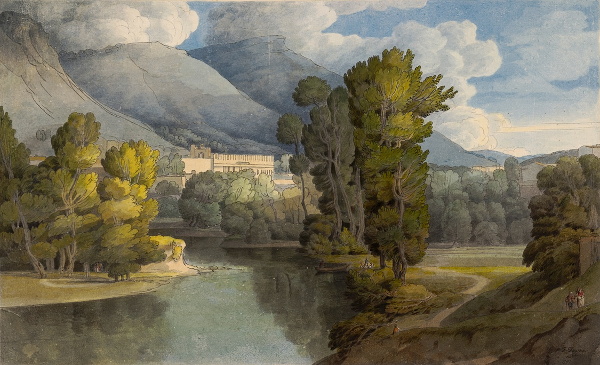
Above: ‘Light and shadow passing like ghosts through the landscape’: At Tivoli, above the Falls, 1781
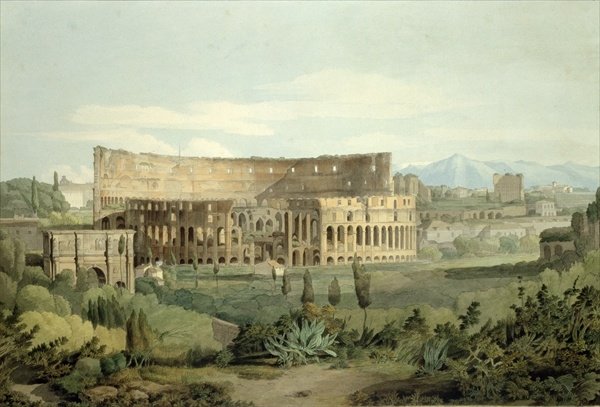
Above: The Colosseum from the Caelian Hills, 1799
Here are the 113 results of a search for Francis Towne at the British Museum site. Lots of wonderful watercolours to admire.
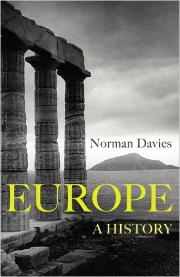
One of the books I got at Christmas was Europe: A History by Norman Davies. This is a big history book, over 1300 pages. I recently read Davies' Vanished Kingdoms and thought it was extremely good.
One of the things I like about him as a historian, apart from being an interesting and knowledgeable writer, is that he gives proper coverage to the entirety of Europe, that is: East, Central and Northern Europe, as well as the usual Western part. To understand and appreciate the history, one needs to know the background to Russia, Poland, Lithuania, Moravia, Ukraine, Hungary and all the other neglected parts of the continent. He wants a less parochial history of Europe.
I would like to post the odd snippet from the book as I find them.
On some of the legacy of the post-Roman world and the great migrations in the centuries after:
Greek persisted in the Eastern Empire, both as the official language and in many places, especially in Asia Minor, as the vernacular. But several areas, including the Peloponnese, were for a period wholly or partly slavicized. One should be wary of oversimplification. But the thesis advanced by the Bavarian scholar, Jakub Fallmerayer (1790-1861), in Ueber die Entstehung der Neugriechen (1835), merits attention. Fallmerayer's work, which caused deep trauma amidst the Greeks of his day, argued that the Greek nation of modern times was largely descended from hellenized Albanians and Slavs, "with hardly a drop of true Greek blood in their veins". This may have been an exaggeration; but it is less absurd than the notion that every modern Greek is a direct ethnic descendant of the inhabitants of ancient Greece. No modern European nation can lay reasonable claim to undiluted "ethnic purity".
At the National Gallery and paying some attention to 17th Century Spanish paintings, I came across a Velázquez, Philip IV hunting Wild Boar (La Tela Real) :
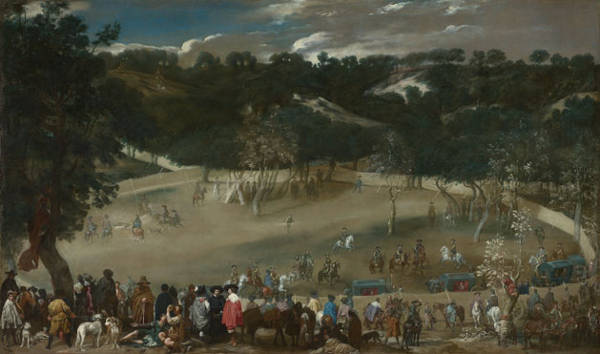
Diego Velázquez, Philip IV hunting Wild Boar (La Tela Real). Probably 1632-7.
Oil on Canvas. Dimensions 182 x 302 cm
It is quite a large picture (182 x 302 cm) and a very good piece of work, but not one that grabs you like one of his portraits or religious paintings. There's a lot going on and what is particularly well done is his attention to the figures. He captures each one with a few strokes of the brush, no extra fine detailed work but enough to capture the whole. All the (many) figures look good. This ability to do so much with so little effort is why Velázquez is a great artist.
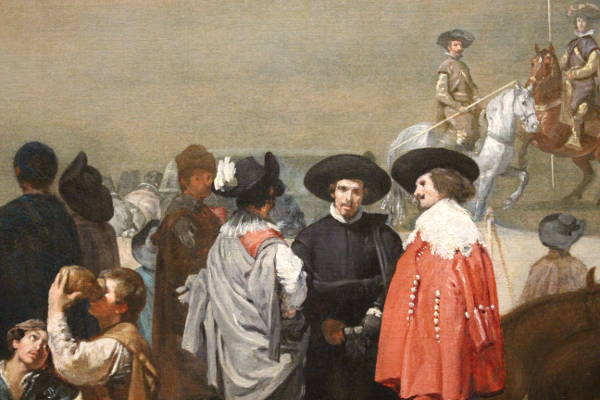
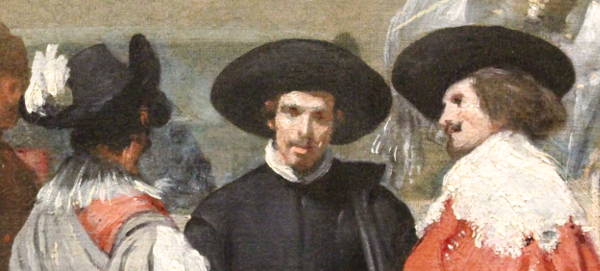
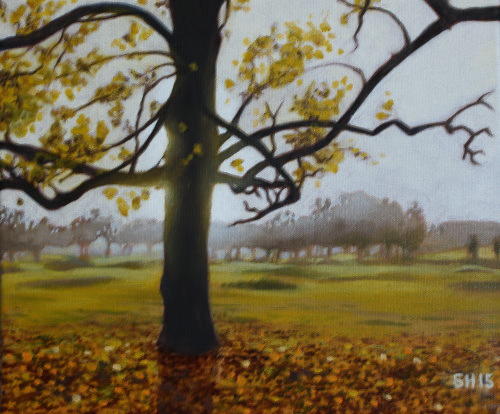
This is "A Common Tree", a painting from a photograph I took of a tree on Clapham Common a year ago. It was a cold late November day, mid-afternoon but the sun was starting to set and the shadows lengthening. Painted almost a year later, November 2015.
This is my first painting done using oils, a medium I liked but one that will take some getting used to. The slow drying is both a blessing and a curse. But overall, I really enjoyed painting this, even though I had trouble in some places. I like the end result.
Once again, the photograph of the painting leaves a bit to be desired compared to the painting itself though.




